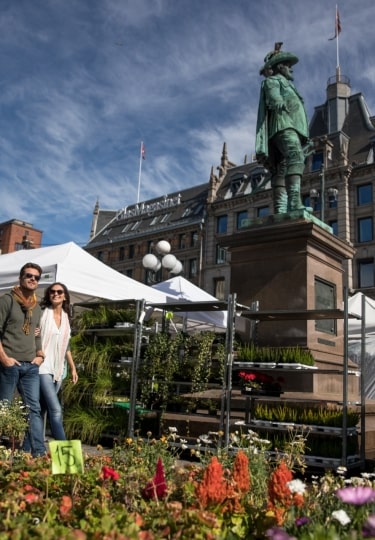Some of the best things to do in Oslo include dedicating time to the city’s cutting-edge museums and galleries, many of which are clustered near the waterfront, including MUNCH, the Astrup Fearnley Museum of Modern Art, and the National Museum.
Oslo puts on a fabulous display of modern architecture including the Norwegian Opera & Ballet House. The city also preserves its treasure trove of centuries-old landmarks, such as Oslo Cathedral and Akershus Castle.
From grazing on street food to hiking to hidden lakes, here is a comprehensive guide to all of the best things to do in Oslo.
Join a Guided Tour of the Royal Palace
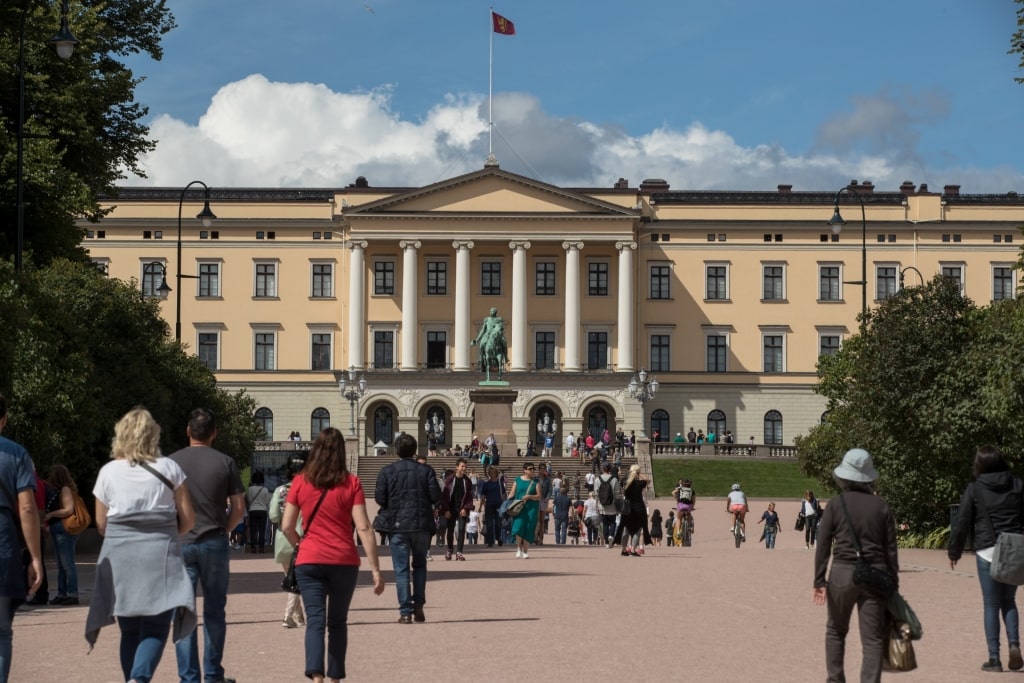
Royal Palace
The Royal Palace lies in the center of Palace Park, an immaculate green space at one end of Karl Johans Gate, Oslo’s main thoroughfare. A guided tour of the Royal Palace is one of the best things to do in Oslo.
The palace that Norway is known for was completed in 1849 and King Oscar I was the first monarch to take up residence here. Today, the House of Glücksburg, led by King Harald and Queen Sonja, continue to live at the Royal Palace and carry out their constitutional duties.
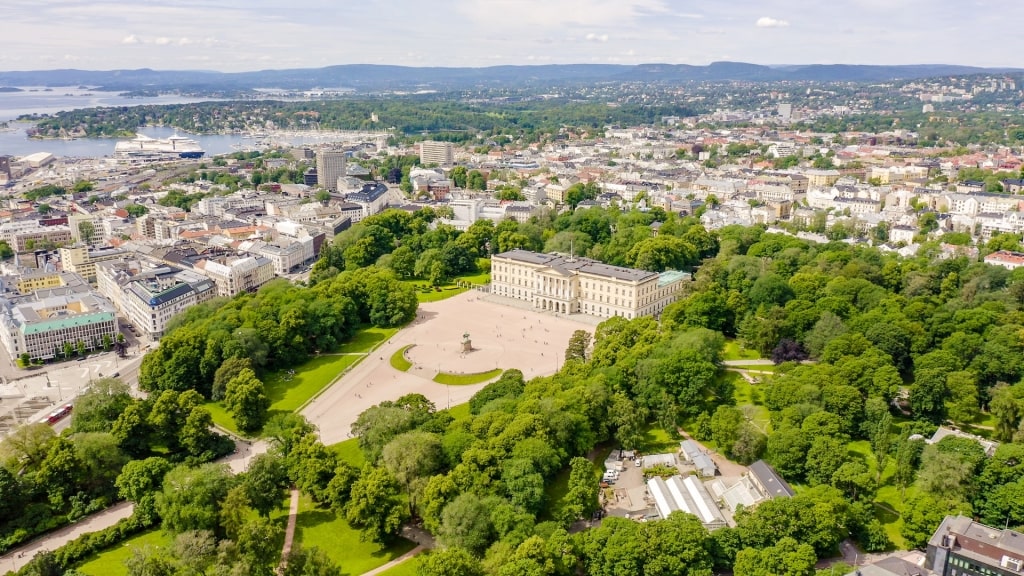
Royal Palace
While visitors can wander the Royal Park and admire the Royal Palace year-round, summer is the best time to visit, with the Palace’s gilded doors open to the public between late June and mid-August.
The Royal Palace’s oatmeal-hued exterior features an elegant Neoclassical stuccoed facade with pillars facing a statue of Karl Johan, the monarch who commissioned the building.
Inside, a guided tour takes travelers into sublime staterooms, including the whimsical Bird Room, where those waiting for an audience with the King wait, plus the Ballroom and Banqueting Hall. Both have hosted royalty and heads of state from around the world.
A highlight is a crystal-tiered chandelier hanging in the Ballroom and The White Parlour, once used as Queen Joséphine’s audience chamber in the 1800s.
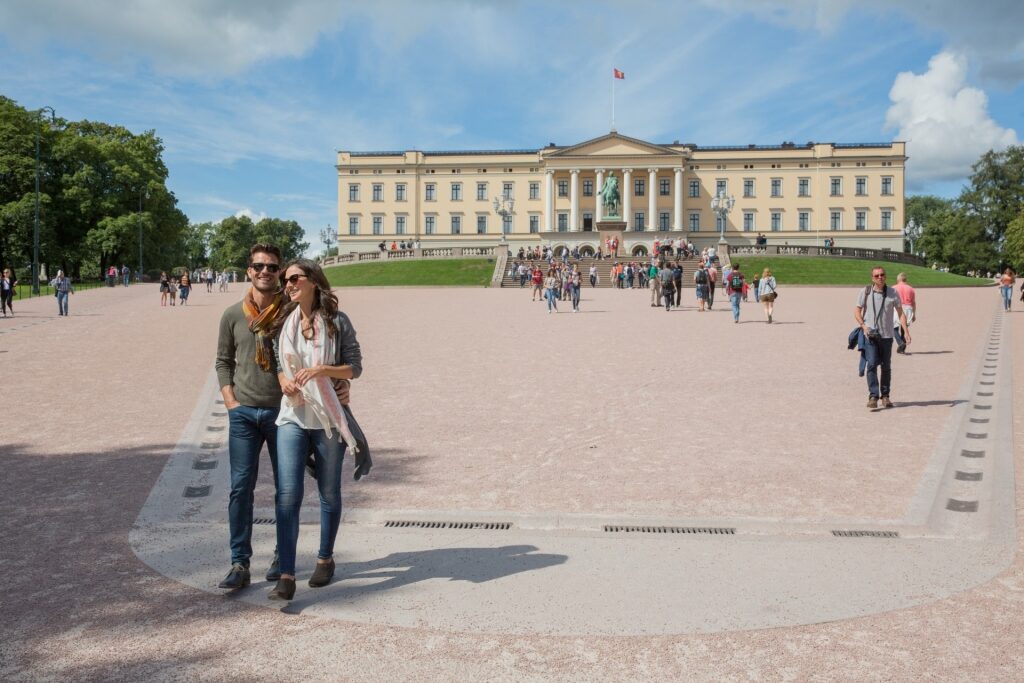
Royal Palace
Outside, stroll among the Palace Park, with its ancient trees, ponds, and a small stream linking two of the larger ponds.
Read: Beautiful Places to Visit in Norway
Visit the Oldest Building in Oslo
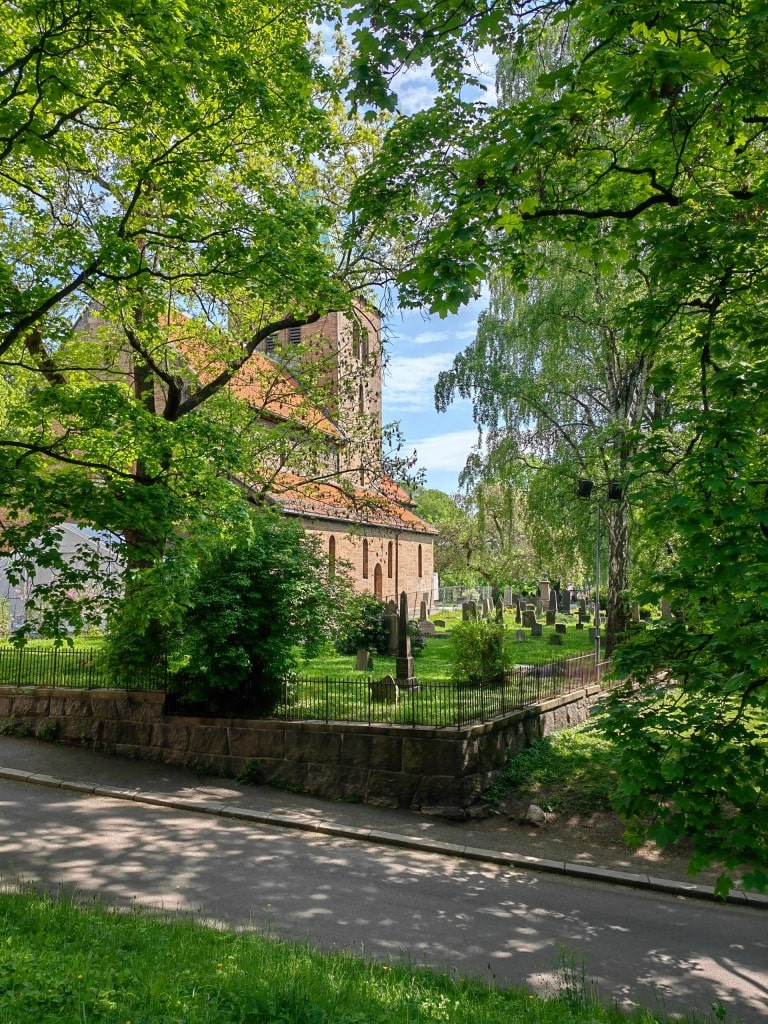
Old Aker Church
Following a year-long renovation, visitors can once again step inside Oslo’s oldest building, the well-preserved Old Aker Church in the north of Oslo. Constructed around 1150 (though there have been more recent additions, such as the tower, added in 1861), Old Aker Church features a Roman-style basilica with three naves.
The church is located in one of the oldest parts of Oslo, around a 20-minute walk from the Royal Palace. Step inside to marvel at this medieval building, which almost resembles a dramatic movie set, with beautiful stained-glass windows and a baroque pulpit.
Adjacent to Old Aker Church is the Cemetery of Our Saviour. Created in the 18th century, it is the resting place of Arctic explorer Eivind Astrup and the painter Edvard Munch, whose famous works include “The Scream”. Prime ministers, writers, politicians, composers, and high-ranking military officers are also buried in this quiet spot.
Take a Peek Inside Oslo Cathedral
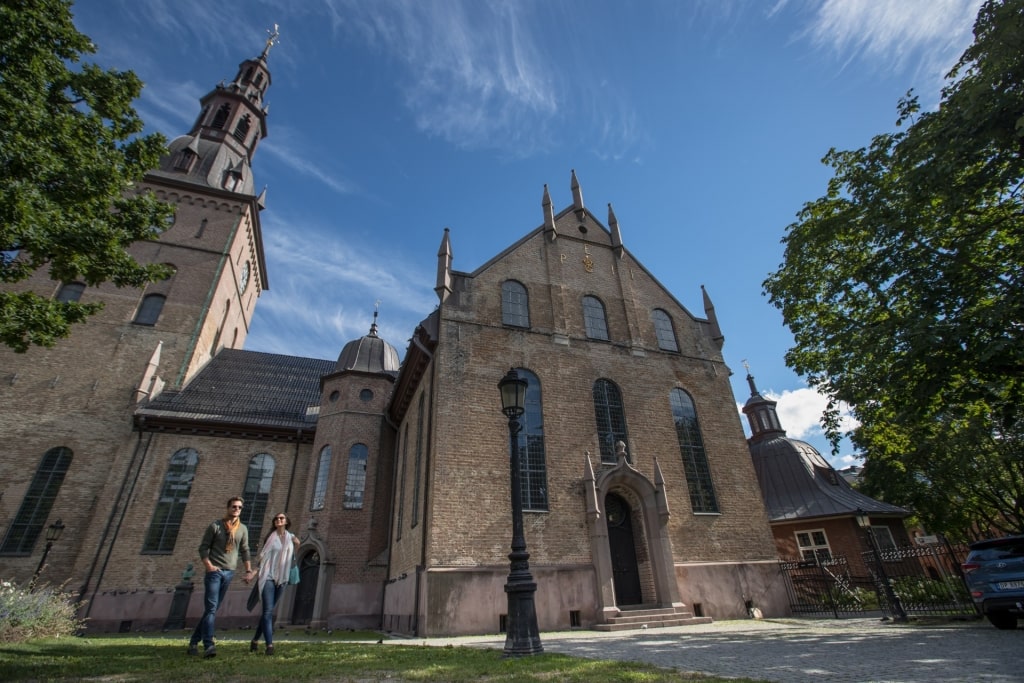
Oslo Cathedral
Home of the Oslo Cathedral Boys’ Choir and Oslo Cathedral Youth Choir, this Baroque church is central to the city, located on Stortorvet in downtown Oslo.
Built in the late 1600s, Oslo Cathedral has a modest exterior that’s free of gargoyles and statues. Inside, however, Oslo Cathedral glows with decadent details, including an original altarpiece, pulpit, and facade of the main organ, with colorful ceiling murals added in the 20th century by Norwegian painter Hugo Lous Mohr.
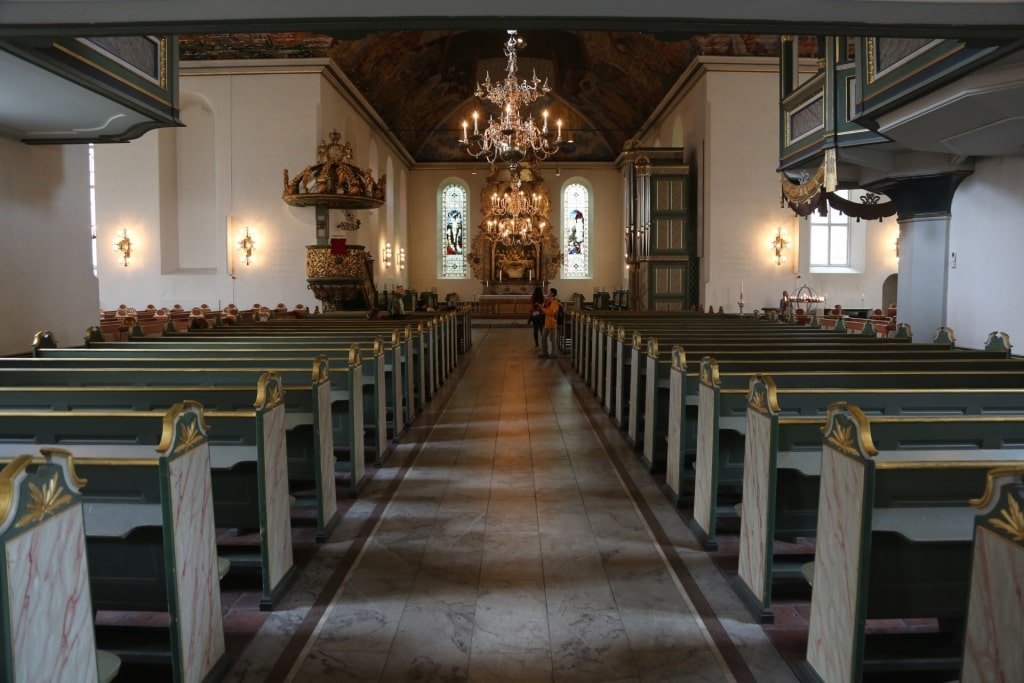
Oslo Cathedral Photo by Hans A. Rosbach on Wikimedia Commons, licensed under CC BY-SA 3.0
Oslo Cathedral hosts a daily mass and is used for state ceremonies such as royal weddings, including that of Prince Haakon and Princess Mette-Marit Tjessem Høiby in 2001.
Once you’ve gazed at the artwork and perhaps caught a choir rehearsal, enjoy a spot of shopping nearby. The cathedral is well placed for browsing the upmarket Illums Bolighus department store, just across from the church.
Discover the Natural History Museum’s Botanical Gardens
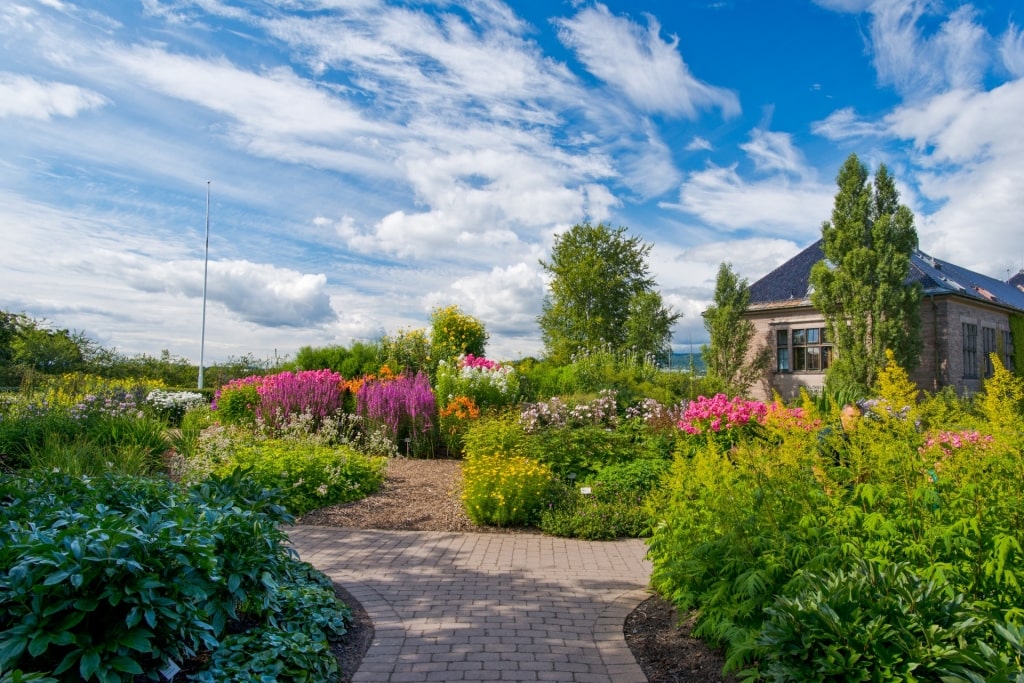
Botanical Gardens
Part of the city’s Natural History Museum, the verdant Botanical Gardens is one of the best attractions in Oslo. There are roughly 4,500 different plant species here, including a variety of trees and shrubs from around the world, such as cactus, palm trees, and ferns, with gardens divided into themed sections.
Explore the tree-filled Arboretum, which covers the majority of the Botanical Gardens. It’s home to around 1,800 plants, including a single white mulberry tree, cherry trees, yellowwood, dove trees, robinias, elder, and magnolia trees, with handsome conifers lining the western slopes.
One of the more unusual trees is the Temple Tree. Planted in 1870 and native to East Asia, it blossoms with a pretty pink and orange flower. Wander through the thoughtfully-designed Scent Garden, and spot the five willow sculptures by British artist Tom Hare dotted around the Botanical Gardens.
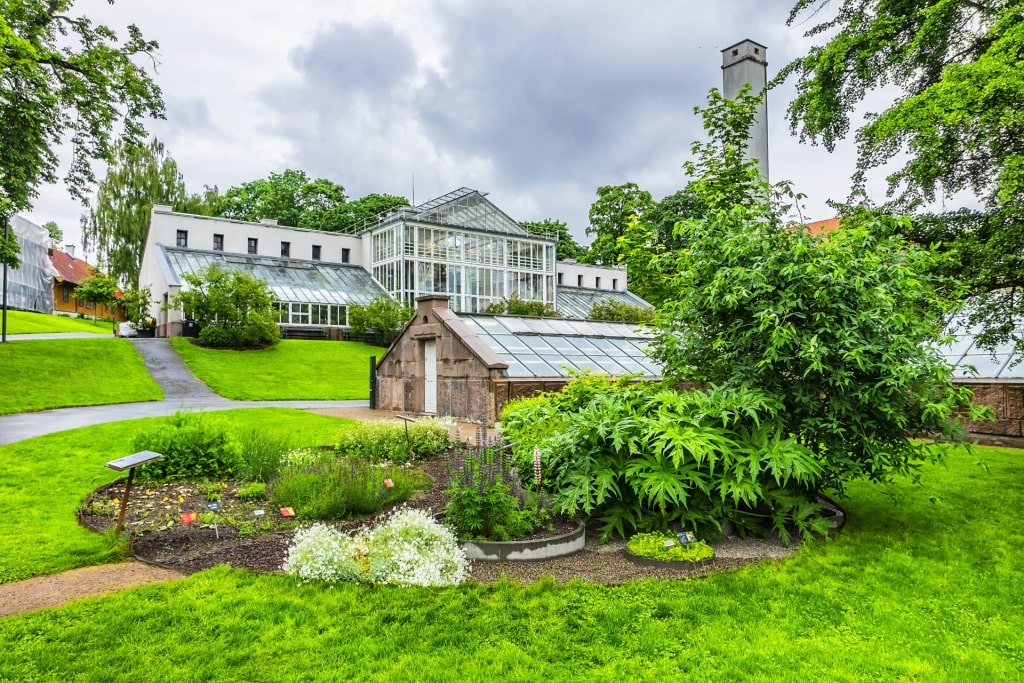
Palm House, Botanical Gardens
Further highlights include the two glasshouses, with the triple-height Palm House, built in 1868, and The Victoria House,§ built in 1876.
Save time to discover the relics at the Natural History Museum, including some six million botanic, geological, and zoological finds, such as species discovered in remote Norweigan forests through to the extinct Tasmanian pungull.
Guided tours, family activities, nature-themed talks, and changing exhibitions feature on the Natural History Museum and Botanical Gardens’ public program.
Roam Akershus Castle
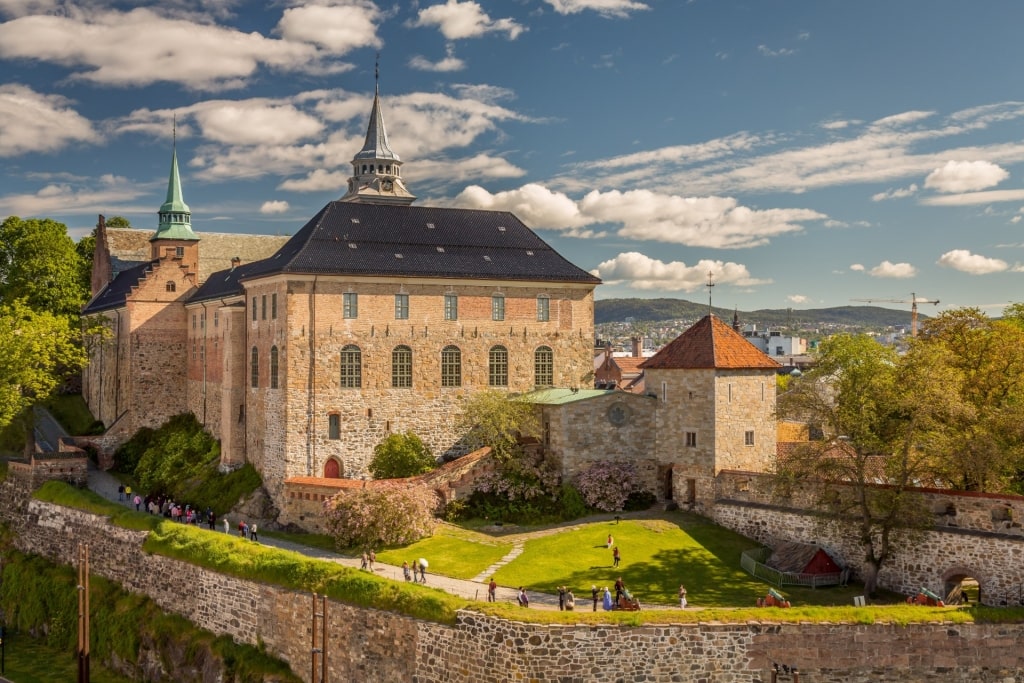
Akershus Castle
Visiting Oslo’s Akershus Castle is one of the best things to do in Norway. This medieval fortress is located by the city’s waterfront, built by King Håkon V in the 14th century. As well as being the city’s gatekeeper, Akershus Castle has served as a royal residence and as a prison when used by the Germans during World War II.
A one-hour tour of this Norwegian castle offers a glimpse into medieval life in Oslo, including a visit to the dimly-lit dungeons, the royal mausoleum, where members of the Norwegian royal family are buried, the castle church, and the storied halls.
Akershus Castle continues to flex its military prowess as the home of the Armed Forces Museum. Learn about the military history of Norway, from the Viking period through to the present day, through the museum’s interactive exhibitions.
Tour Norway’s National Gallery
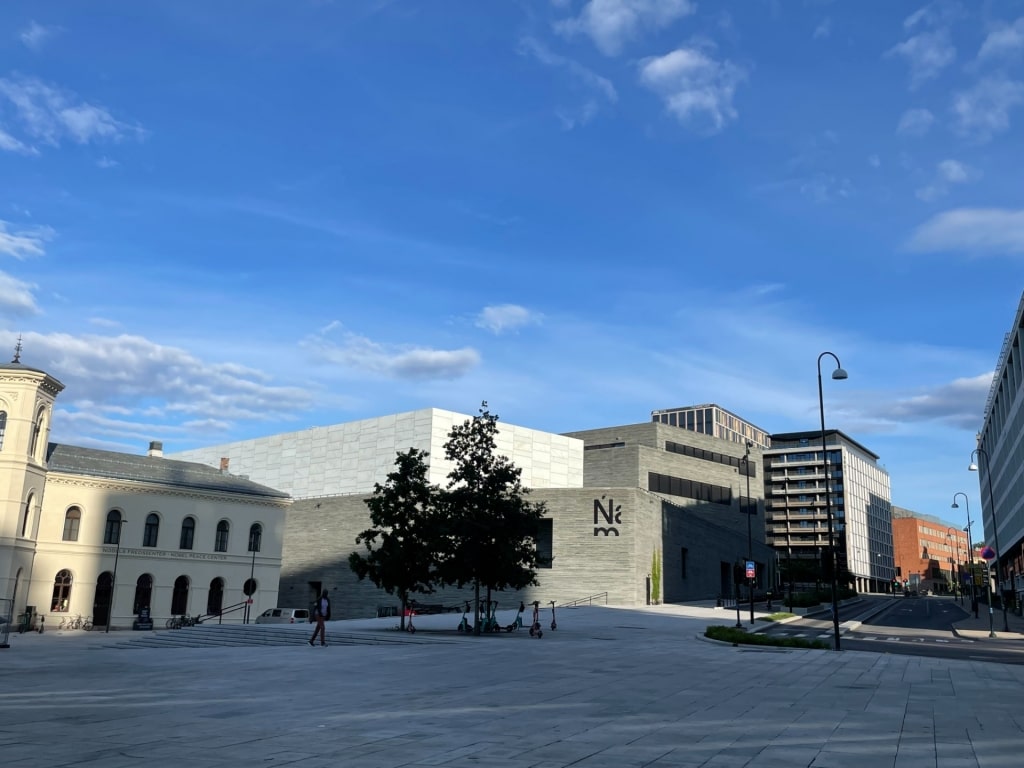
National Museum Photo by Ssu on Wikimedia Commons, licensed under CC BY-SA 4.0
Losing several hours at this colossal museum, the largest in the Nordic countries, located next to the harbor, is one of the best things to do in Oslo.
The sleek National Museum opened in the capital in 2022, joining together the National Gallery, the Museum of Contemporary Art, and the Norwegian Museum of Decorative Arts and Design, all under one gigantic roof. There are 6,500 works of art to admire, from antique vases and sculptures to modernist paintings.
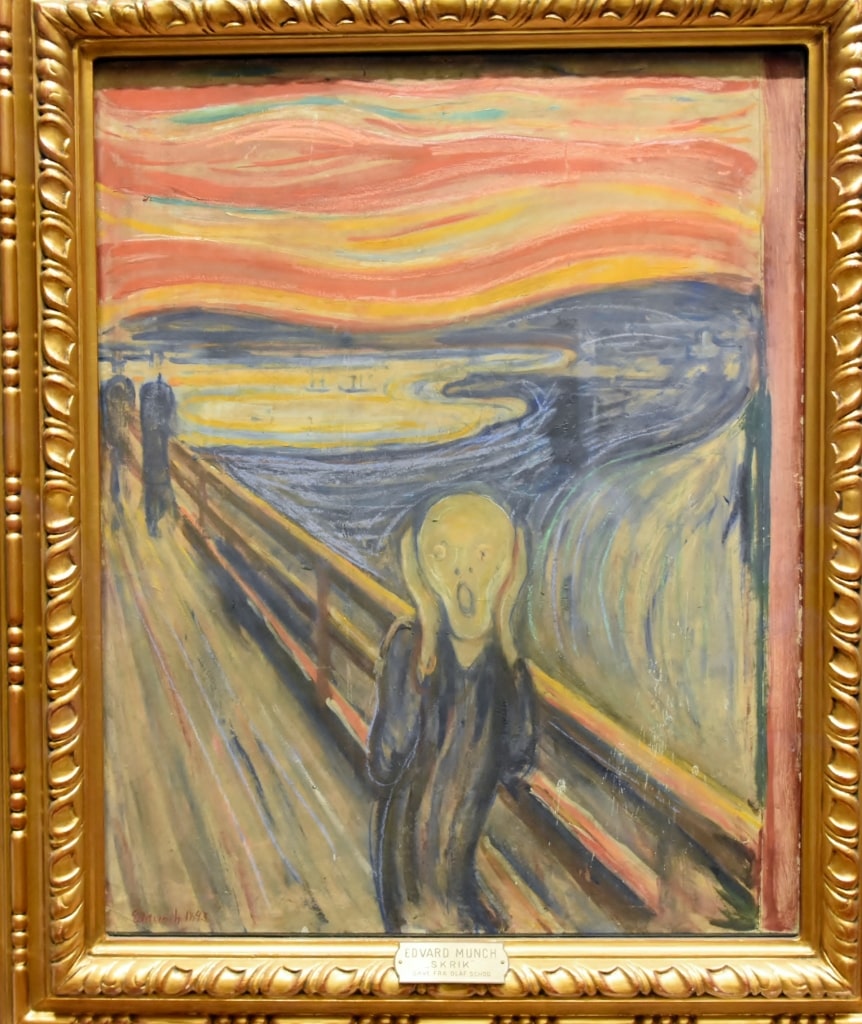
Scream by Edvard Munch Photo by Richard Mortel on Flickr, licensed under CC BY 2.0
There’s a space dedicated to Norwegian artist Edvard Munch. It’s here, inside the Munch Room, that visitors can gaze at a version of “The Scream,” painted in 1893, and “Madonna,” 1894.
Other Norwegian artists on display include Christian and Oda Krohg, Harald Sohlberg, and Harriet Backer, along with works by Pablo Picasso, Paul Gauguin, Claude Monet, Auguste Renoir, and Paul Cézanne.
Tour at your own pace or join a 2 p.m. guided tour on a Tuesday or Wednesday. Skip up to the roof terrace, too, for unbeatable views of the inner Oslofjord.
Witness Oslo’s Beautiful Waterfall
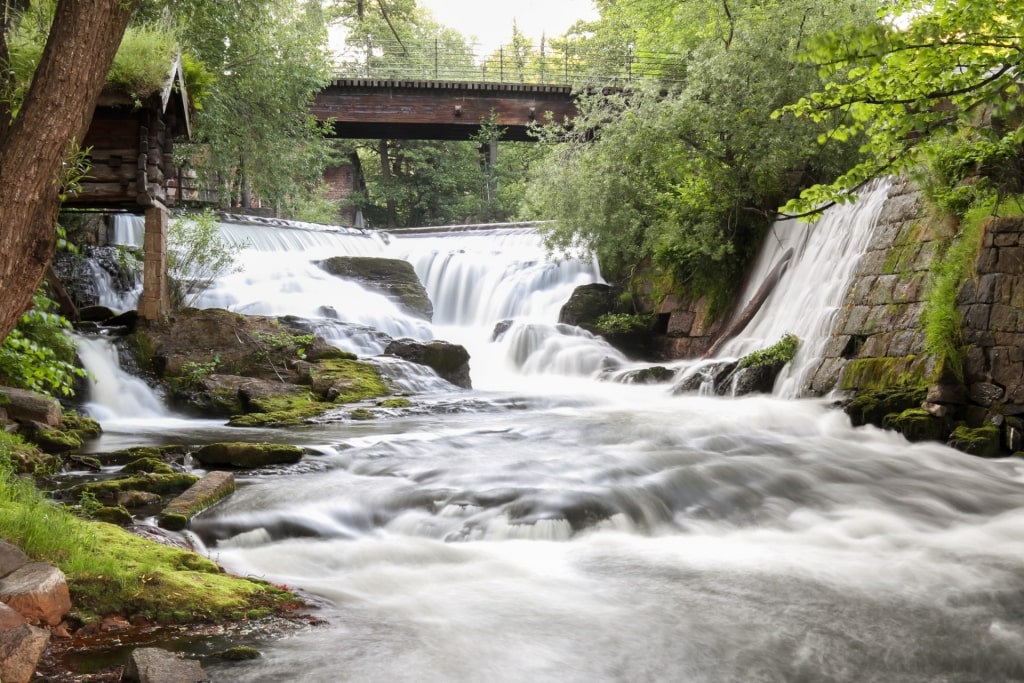
Vøyenfallene waterfall
Not only is Oslo a thoroughly modern and cosmopolitan city, but it has no shortage of natural attractions, too, including an attractive waterfall on the Akerselva River.
Vøyenfallene waterfall is located in the charming Torshov neighborhood, next to a tall red-brick building. A wander along a stretch of the river, which makes its way south from Maridalsvannet to the Oslofjord, offers the chance to take in this urban waterfall in Norway.
Continue north from Vøyenfallene a short distance to Beier Bridge and there’s a lovely café where you could stop and enjoy some of Norway’s famously good coffee and cake. The café is located at Hønse-Lovisa’s house, a gorgeous traditional red house built in 1800 that’s now a museum.
Bathe on Tjuvholmen City Beach
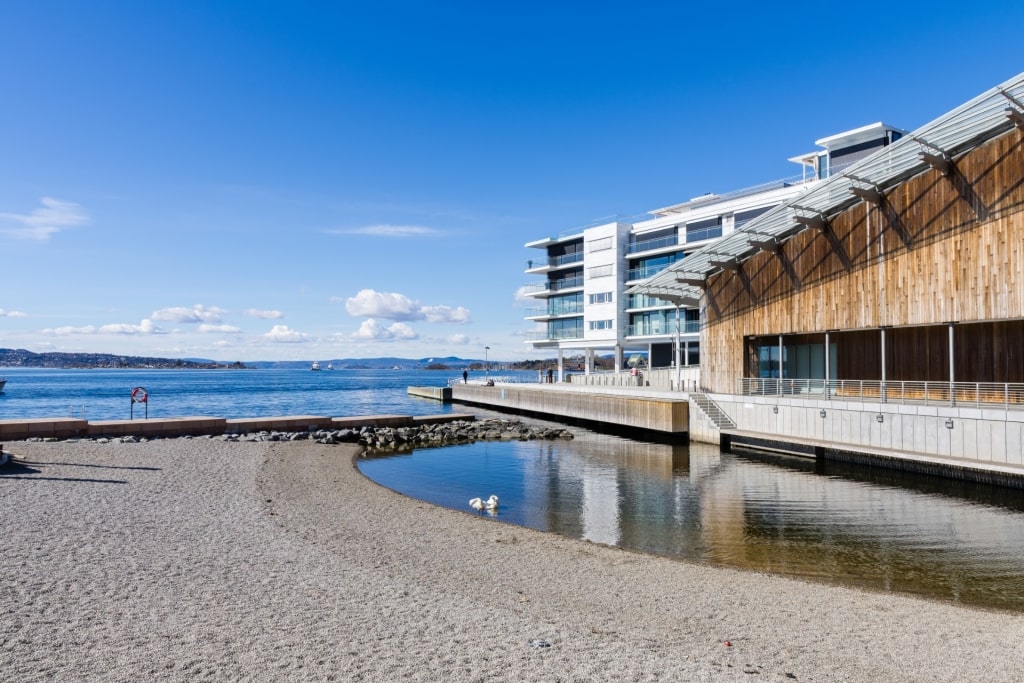
Tjuvholmen City Beach
With temperatures reaching 73°F in summer, you might want to consider a trip to one of Oslo’s city beaches. Spending time at Tjuvholmen is one of the best things to do in Oslo in the warmer months.
Tjuvholmen is a small pebble beach next to the Astrup Fearnley Museum, yet remains one of Norway’s best beaches. It’s a safe swimming spot and is perfect for tagging on to a day of museum-hopping around the harbor.
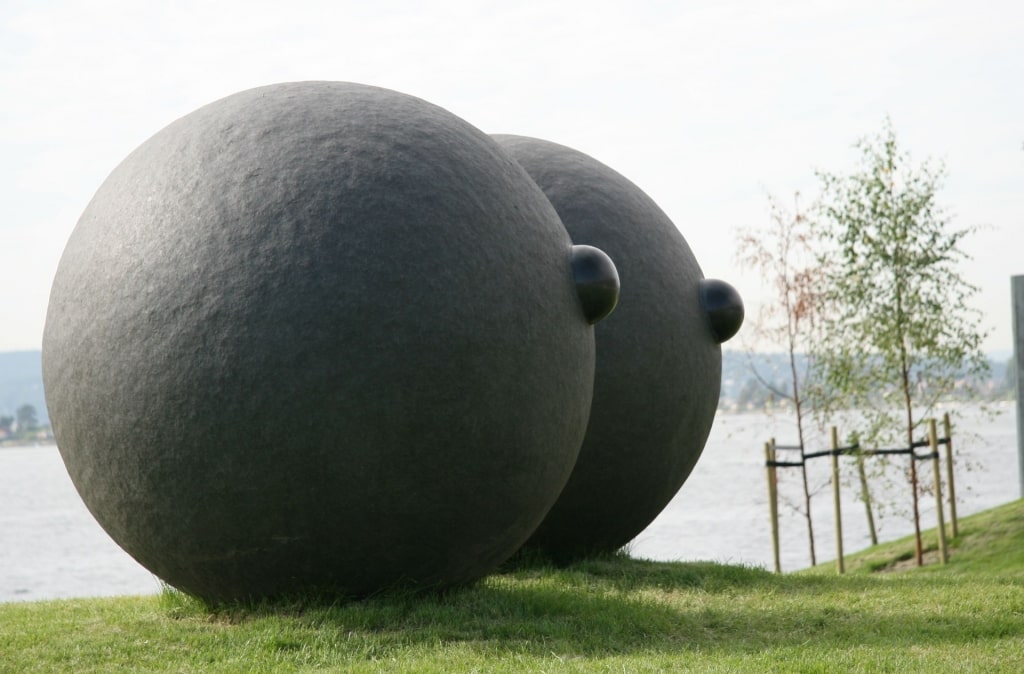
Tjuvholmen Sculpture Park Photo by Michal Klajban on Wikimedia Commons, licensed under CC BY-SA 3.0
Pack a towel to lie on the shore and enjoy the views of Tjuvholmen Sculpture Park, designed by Italian architect Renzo Piano, who also designed the museum. There is a mix of works in the park by world-renowned artists, including artists Antony Gormley, Anish Kapoor, and Franz West.
After a leisurely swim and a wander through Tjuvholmen Sculpture Park, stop for a bite to eat at
VentiVenti at the museum. This Italian restaurant serves sensational fjord views with dishes such as mozzarella, truffle, and salami, as well as ricotta and porcini mushroom ravioli.
Enjoy a Leisurely Day Trip to Vollen
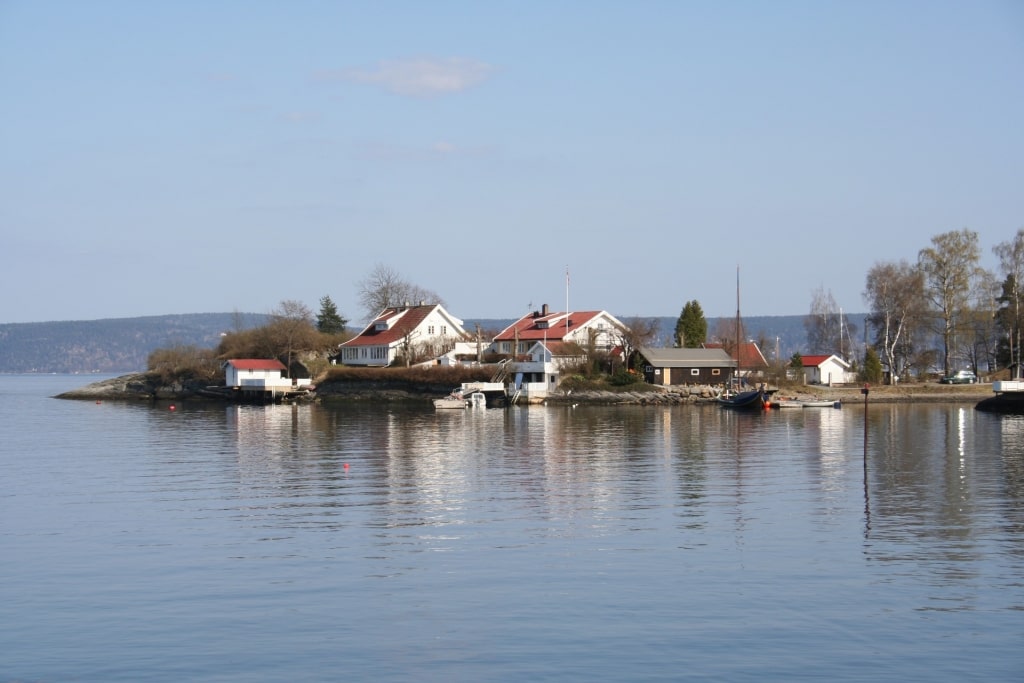
Vollen
Among the best things to do in Oslo is visit Vollen, a charming seaside town on the west coast of the fjord that is steeped in Viking history.
This area’s rich ship-building tradition can be traced back centuries, with a Viking ship from the 13th century discovered in the mud a short distance north of Vollen, in Sjøvollbukta.
The resort is filled with pretty timber-clad white houses, with shops, galleries, restaurants, and cafés scattered near the marina. Stop for a coffee at Café Villa or a glass of wine at Napa Winebar & Craft Beer.
Walk the short distance along the coastal path to the Oslo Fjord Museum, taking around five minutes, to learn about Vollen’s boat-building industry. The museum is located at the spot where the great Norwegian explorer Roald Amundsen’s polar ship, Maud, launched in 1917.
Stories about the Norwegian fjord and its communities are shared at the exhibition, and several boats are on display.
You can reach Vollen by taxi, which takes around 30 minutes. There’s also a regular speedboat service from Oslo to Vollen and the 250 bus operates from Oslo to Slemmestad, via Vollen.
Spend Time in Hip Grünerløkka

Grünerløkka Photo by Jorge Franganillo on Wikimedia Commons, licensed under CC BY 2.0
Grünerløkka is an intimate neighborhood in the northeast of Oslo, to the east of the Akerselva River.
Grünerløkka has a village-like feel, with vibrant street art and garlands of lighting. It’s a wonderful spot for great cafés, restaurants, independent shops, and bars. Grünerløkka is also the place to go for vintage stores and flea markets. There are bakeries, burger joints, and boutique clothes and homeware shops to explore, too.

Tim Wendelboe Photo by Bex Walton on Flickr, licensed under CC BY 2.0
A must-visit is Tim Wendelboe, a coffee roastery, espresso bar, and coffee training center that is known for serving some of the best—if not the best—coffee in Oslo (and Oslo serves some excellent coffee.).
Grünerløkka is a 30-minute walk from the waterfront or you can take the number 12 tram from Kontraskjæret to get here.
Admire Oslo City Hall
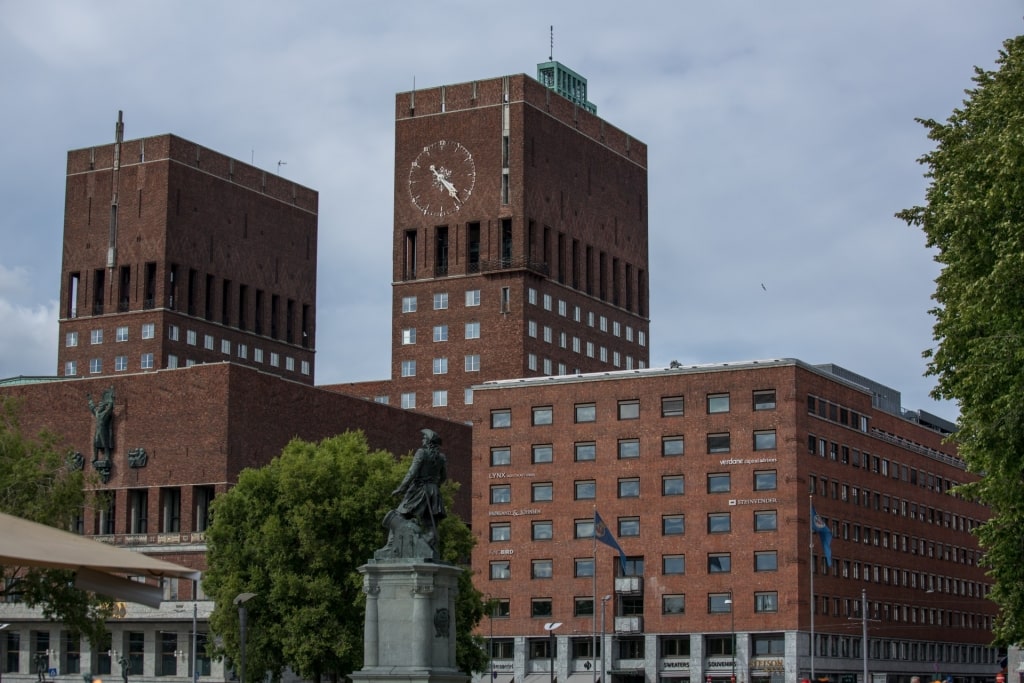
Oslo City Hall
Opened in 1950, Oslo City Hall is a red-brick building with two towers facing the Oslofjord in the center of the city. As well as being the administrative hub of Oslo, it’s where the annual Nobel Peace Prize Ceremony is held every December.
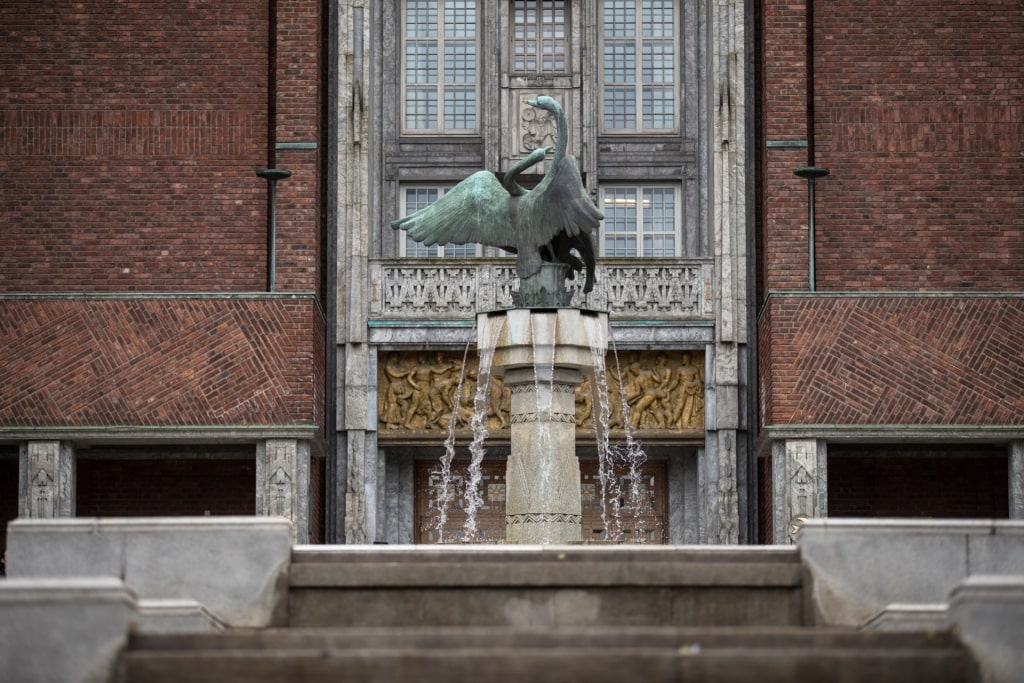
Oslo City Hall
The outside of the building features a series of sculptures, including one of St. Hallvard, the patron saint of Oslo. You’ll also see one of Harald Hardråde, an 11th-century king of Norway, on horseback on the west facade.
Inside City Hall is an oak-clad semi-circular City Council Hall, adorned with a tapestry by Else Poulsson. The Main Hall is clad partly in marble.
Gain an insight into the administrative goings-on of Oslo on a guided tour of the building. Private guided tours can be booked upon request and last for 45 minutes.
Relax in Studenterlunden Park
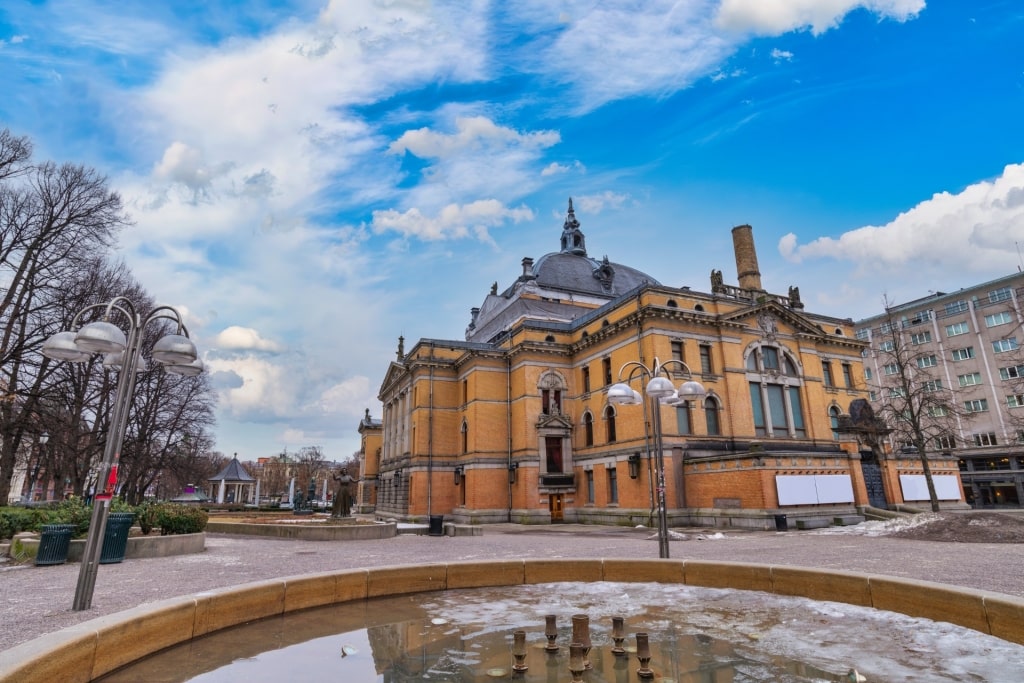
Studenterlunden Park
A rectangular-shaped park in the center of Oslo, Studenterlunden is the city’s answer to New York’s Central Park, only on a much smaller scale.
Studenterlunden is home to Oslo’s National Theatre and is bordered by the Norwegian Parliament to one end and the Royal Park to the other. Large boulevards sweep through Studenterlunden, with rows of bikes for hire.
There’s a music pavilion and statues of famous Norwegians—Johan Halvorsen, Ludvig Holberg, Bjørnstjerne Bjørnson, and Henrik Ibsen—are dotted around.
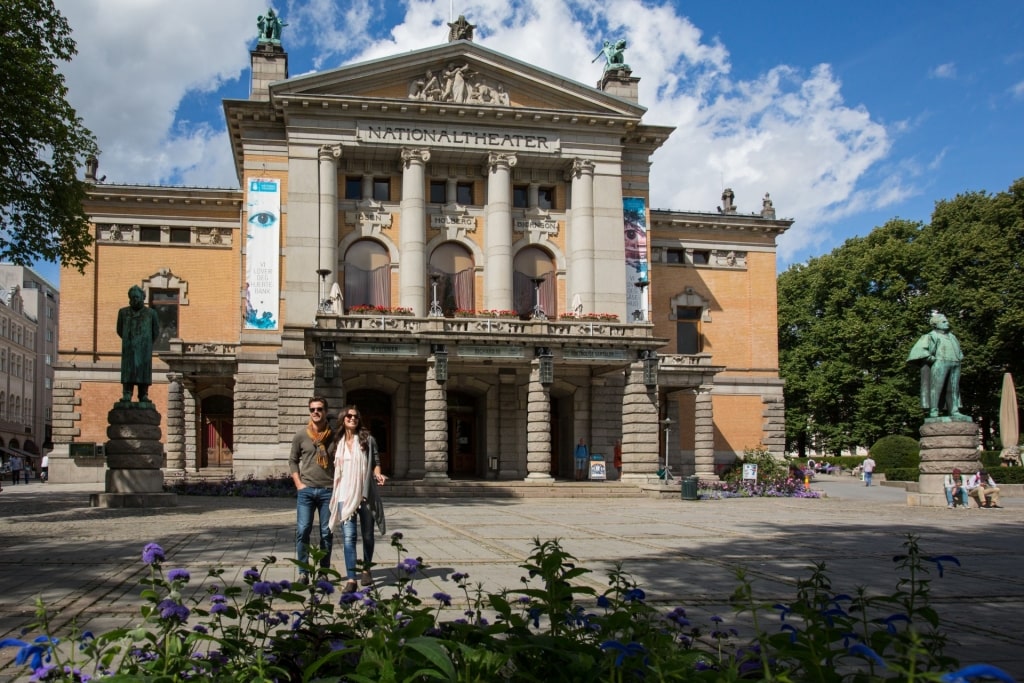
National Theatre
Between sightseeing and shopping, leafy Studenterlunden is a lovely place to take a seat and watch the world go by. If you’re a theater fan, the 1899-built National Theatre offers tours that take you into the bowels of the auditorium, while learning about the history of this elegant theater.
Admire Vigeland Sculpture Park
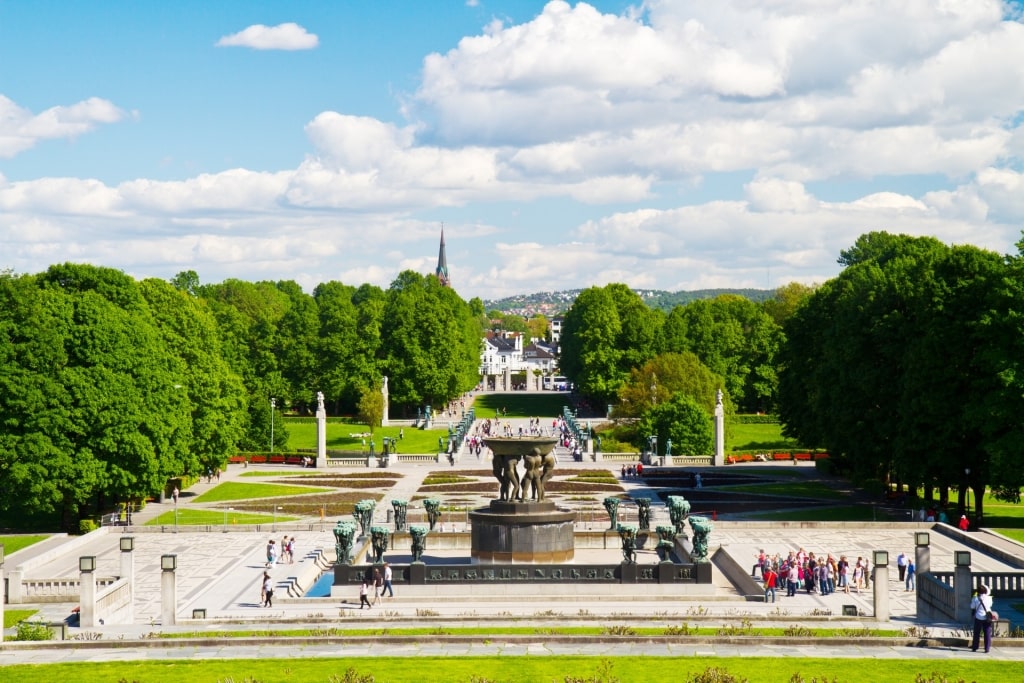
Vigeland Sculpture Park
Situated within the magnificent grounds of Frogner Park—a vast park in the northwest of Oslo—Vigeland Sculpture Park showcases the life’s work of Gustav Vigeland.
Vigeland, whose studio and home were close to the park, dedicated two decades to creating these open-air installations, with more than 212 granite, bronze, and wrought-iron pieces on display.
Cross Vigeland Bridge to witness the 58 haunting sculptures of men, women, and children, including the famous “Angry Boy” that line the path.
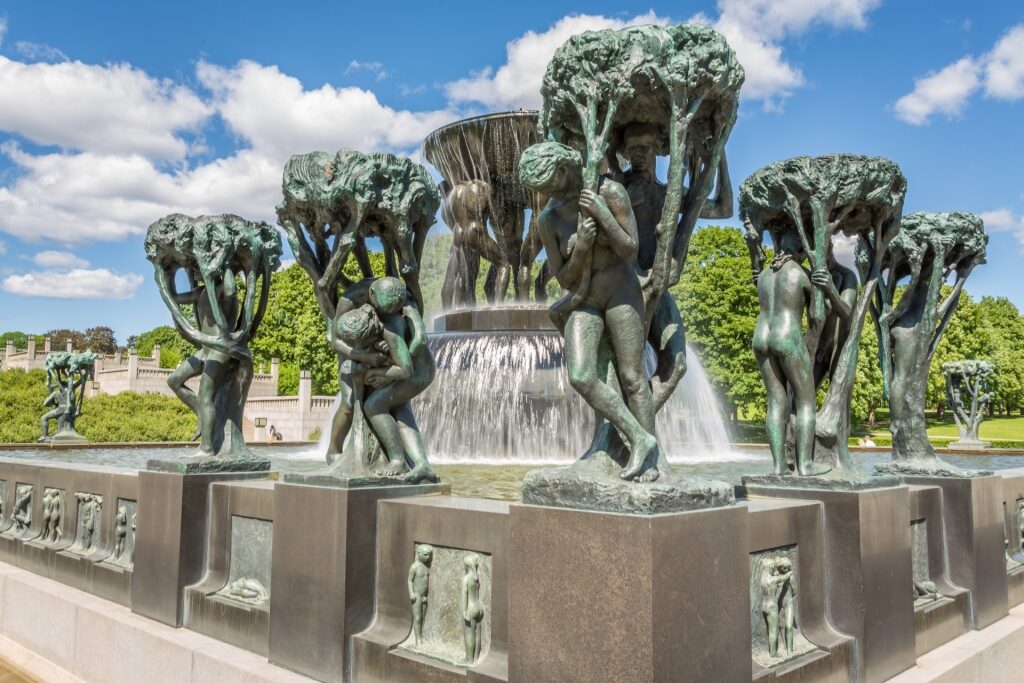
Vigeland Sculpture Park
Stroll through the fragrant rose garden to the “Fountain,” the first of Vigeland’s sculptures installed in the park, and continue to the soaring “Monolith,” decorated with 121 figures grappling to reach the top of the sculpture.
There’s a museum, too, housing more sculptures and a gift shop. Not only did Vigeland donate his life’s work to the Sculpture Park, he designed the park’s grounds, too. The park is free to enter and open year-round.
Ski at Holmenkollen Ski Museum & Tower
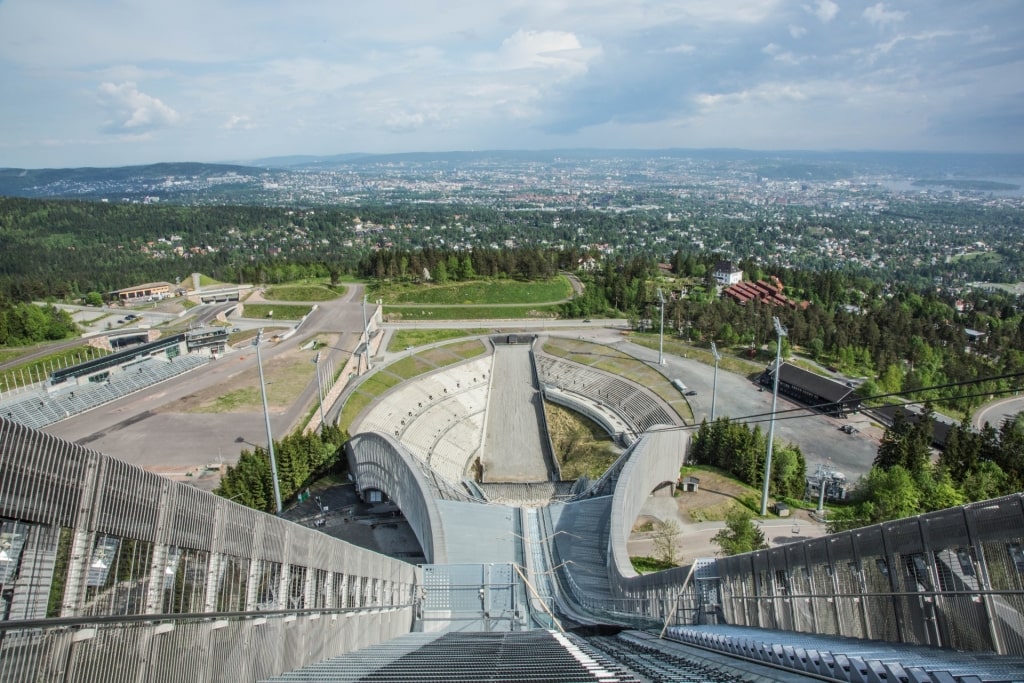
Holmenkollen Ski Museum & Tower
A few miles northwest of the city center, a jaw-dropping ski hill rises 1,400 feet into the sky in Holmenkollen. This urban ski slope with an adjoining museum has hosted the Winter Olympics and Nordic World Ski Championships, plus the Holmenkollen Ski Festival since opening in 1892.
The Ski Jump Tower affords dazzling views of the city and surrounding landscape, while the ski simulator offers visitors the chance to race down slopes at almost 100 km (62 miles) per hour.
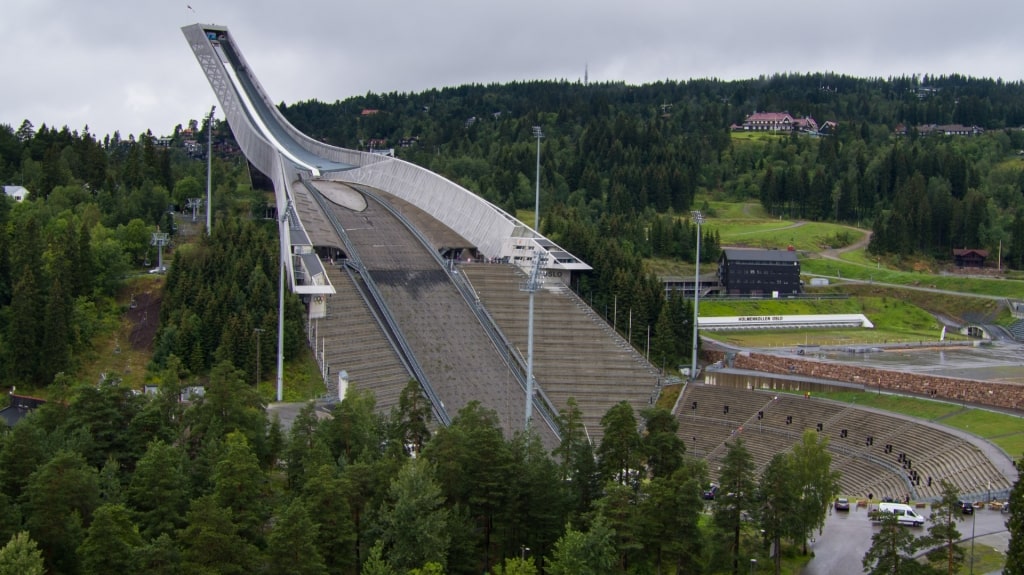
Holmenkollen Ski Museum & Tower
At the Ski Museum, learn about skiing’s place in Norwegian culture as both a sport and a form of transportation. Exhibitions cover famous polar expeditions and display ancient ski artifacts excavated in the wild.
One of the museum’s most fascinating items is a pine ski that is thought to date from the first century, found in a bog in Alvdal in the center of Norway. Joining the collection in 2023 was a ski that’s thought to be over 5,000 years old.
To reach Holmenkollen, take a taxi (roughly 30 minutes) or the number 1 train from Stortinget toward Frognerseteren (around 40 minutes).
Go Backstage at the Norwegian Opera & Ballet House
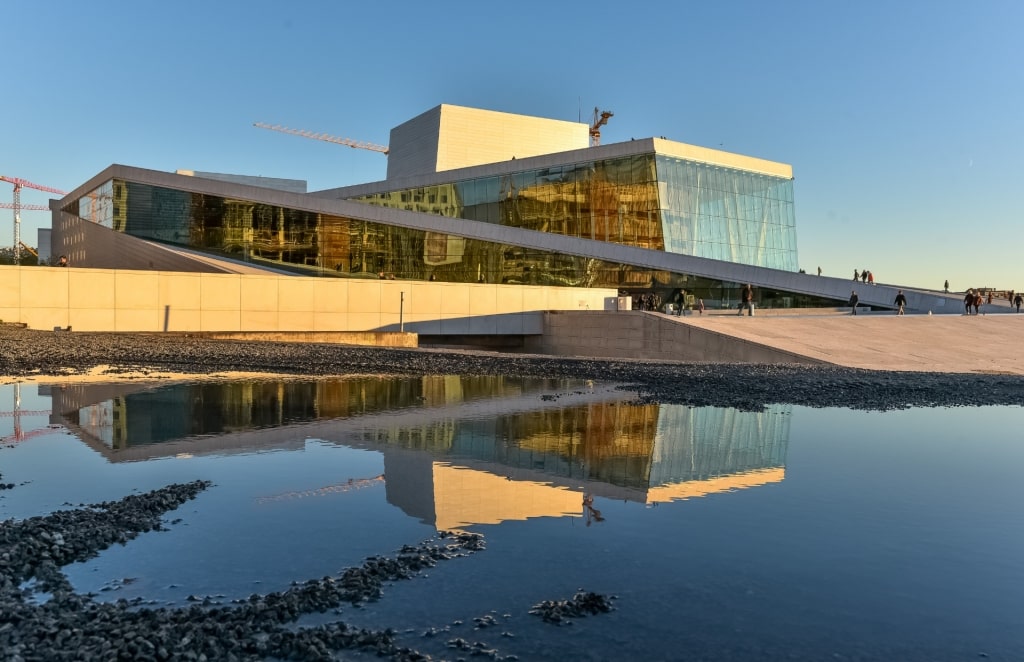
Norwegian Opera & Ballet House
One of the standout buildings on Oslo’s waterfront is the Norwegian Opera & Ballet House, rising like a colossal iceberg that shimmers against the water.
The building opened in 2008 as the home of the Norwegian National Ballet and the Norwegian National Opera and has been one of the best things to do in Oslo ever since.
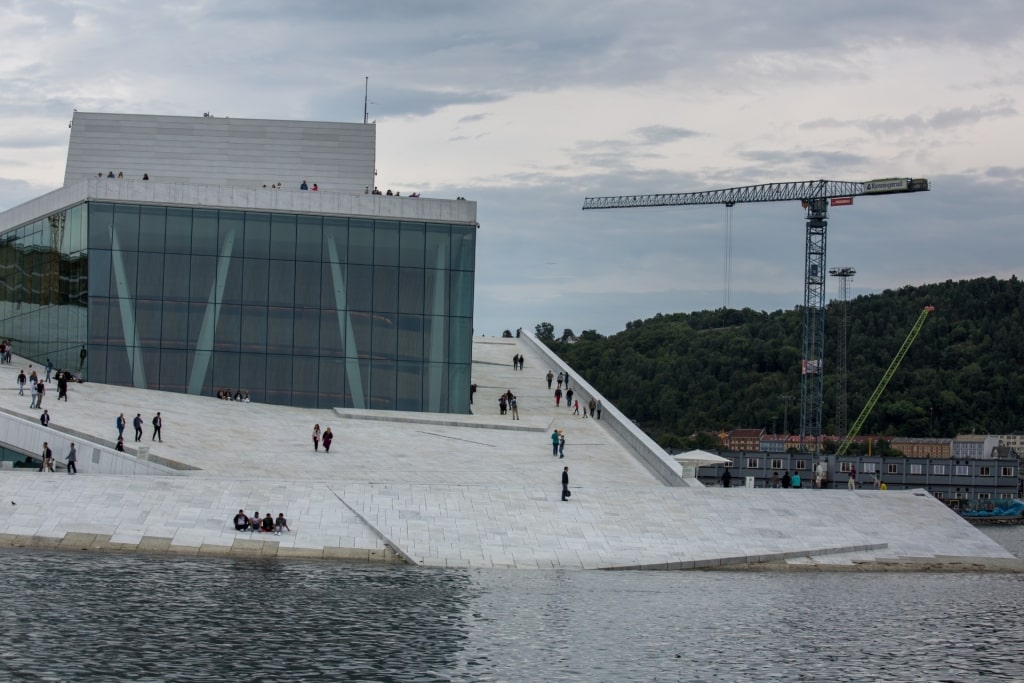
Norwegian Opera & Ballet House
Guided tours take place in English daily, covering backstage and the main stage area. A tour is the best way to learn about the Opera & Ballet House’s architecture and the behind-the-scenes technology involved in creating each performance.
A highlight is walking on the building’s marble-covered sloped rooftop and soaking up views of the Oslofjord. There are two restaurants at the Opera & Ballet House, a seafood restaurant, Havsmak, and Sanguine Brasserie, along with a program of daily performances.
Dedicate Time to the MUNCH Museum
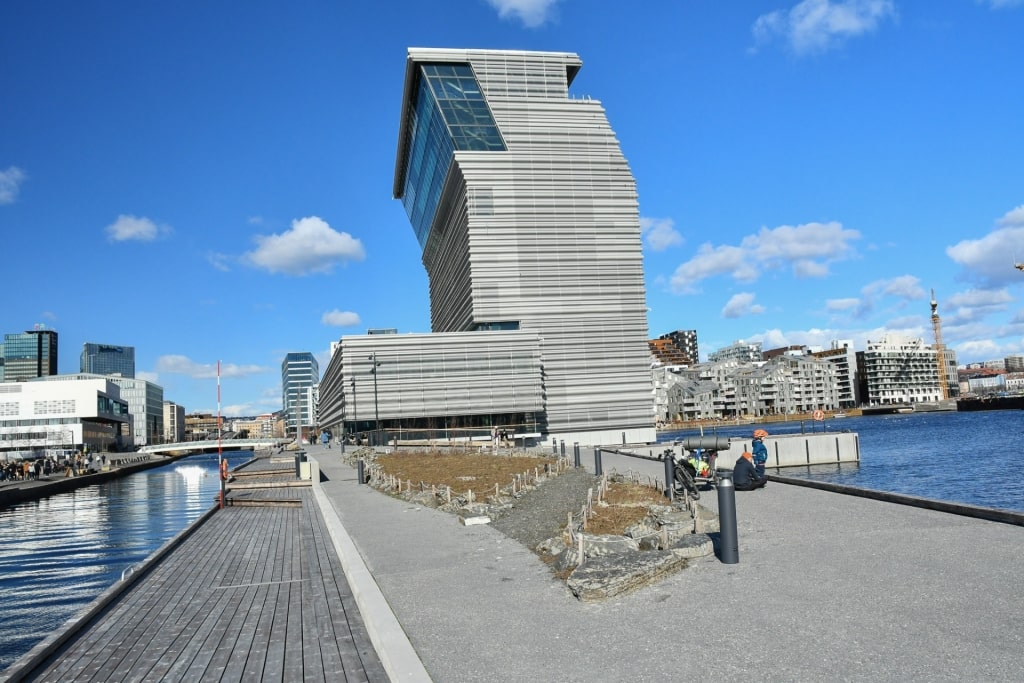
MUNCH Museum Photo by Helge Høifødt on Wikimedia Commons, licensed under CC BY-SA 4.0
Oslo’s new MUNCH museum, next to the Norwegian Opera & Ballet House, opened in 2021, celebrating the legacy of artist Edvard Munch in a brand-new building.
Munch left his entire estate to the City of Oslo, including 28,000 works of art, photographs, letters, and other texts, and before 2021 the museum was located at a smaller site in the Tøyen neighborhood.
From the outside, this eye-catching Estudio Herreros–designed building resembles a vertical deck of playing cards. Inside, there are 11 galleries spread across 13 floors dedicated to Munch’s work, including four variations of “The Scream” (eight versions exist, including one at the National Gallery).
After taking a deep dive into Munch’s work, use the glass elevator in the lobby to reach Kranen, a chic 13th-floor sky bar, for cocktails with a view. There’s also a restaurant, Bistro Tolvte, on the 12th floor, and a caféand a gift store on the ground level.
Discover the Nobel Peace Center
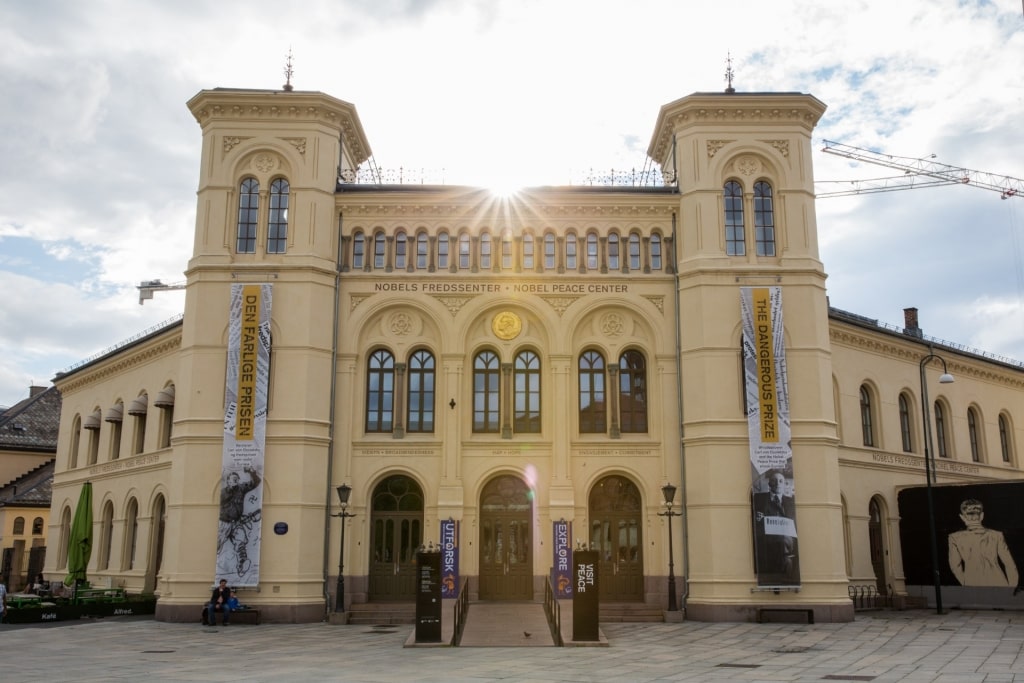
Nobel Peace Center
Located at City Hall Square, the Nobel Peace Center is a museum dedicated to the Nobel Peace Prize, an annual award presented in Oslo every December since 1901.
Various exhibitions reveal what the Nobel Peace Prize is and how it began. The Nobel Field exhibit profiles every Nobel Peace Prize laureate, from Nelson Mandela and Doctors without Borders to Malala Yousafzai, through interactive screens.
The Medal Chamber is an exhibit that focuses on the Peace Prize medal, with one on display that belonged to Norway’s first Peace Prize recipient, Christian Lous Lange. The 18-carat gold medal, designed by Gustav Vigeland, remains the same as it did in 1901.
Drop-in guided tours are available every Saturday and Sunday, lasting 30 minutes, and private tours can be organized upon request.
Unwind in a Floating Sauna
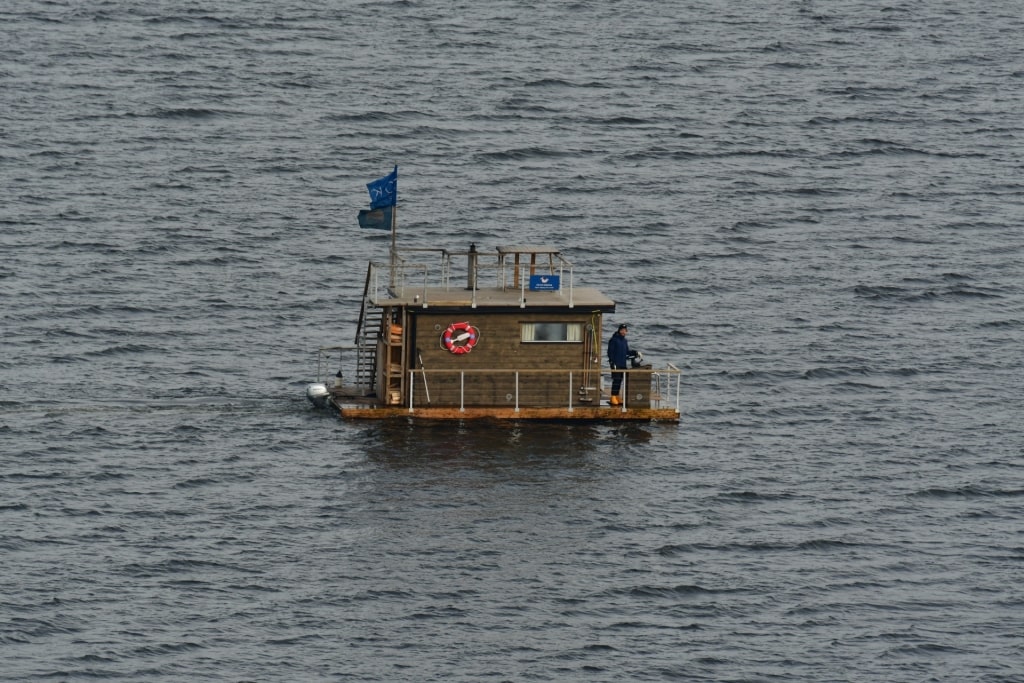
KOK
One of the best things to do in Oslo for relaxation is to strip down to your bathing suit and unwind at a waterside sauna.
Boasting excellent views of the Norwegian Opera & Ballet House and MUNCH, KOK is a floating sauna that’s moored in Aker Brygge, on Oslo’s buzzy boardwalk. A cozy private sauna can be booked out for two hours or you could join a shared sauna (pre-booking is also required).
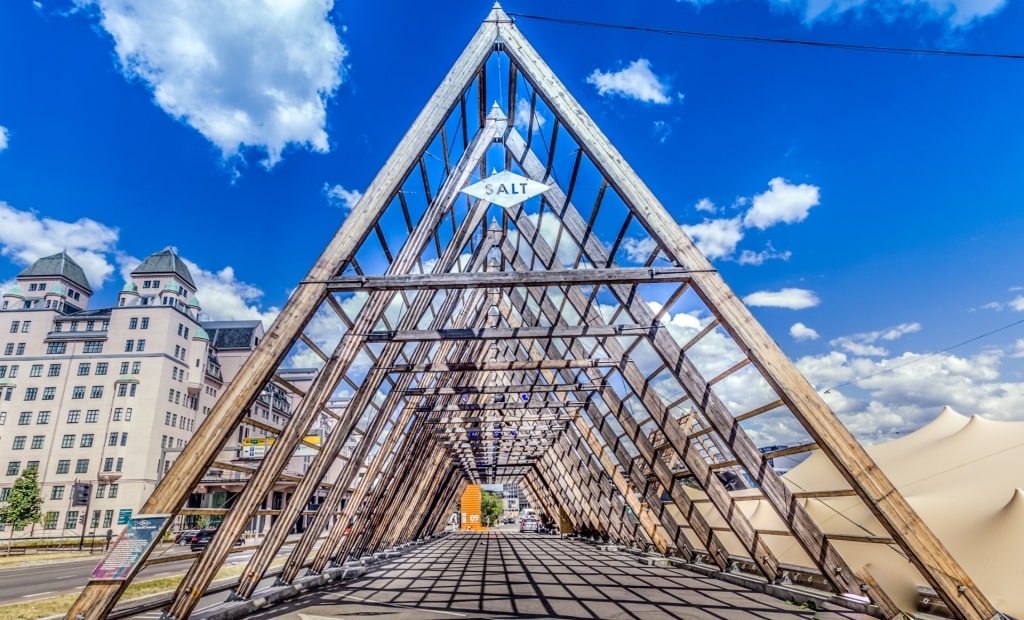
SALT
SALT, an art and music venue on the same stretch of waterfront, also offers communal sauna experiences—pre-book to ensure you get a slot on your desired day. SALT also has cold pools, a bar, changing rooms, and bathrooms.
After, enjoy a stroll along Aker Brygge and stop at one of the bistros and bars.
Discover the Islands of the Inner Oslo Fjord
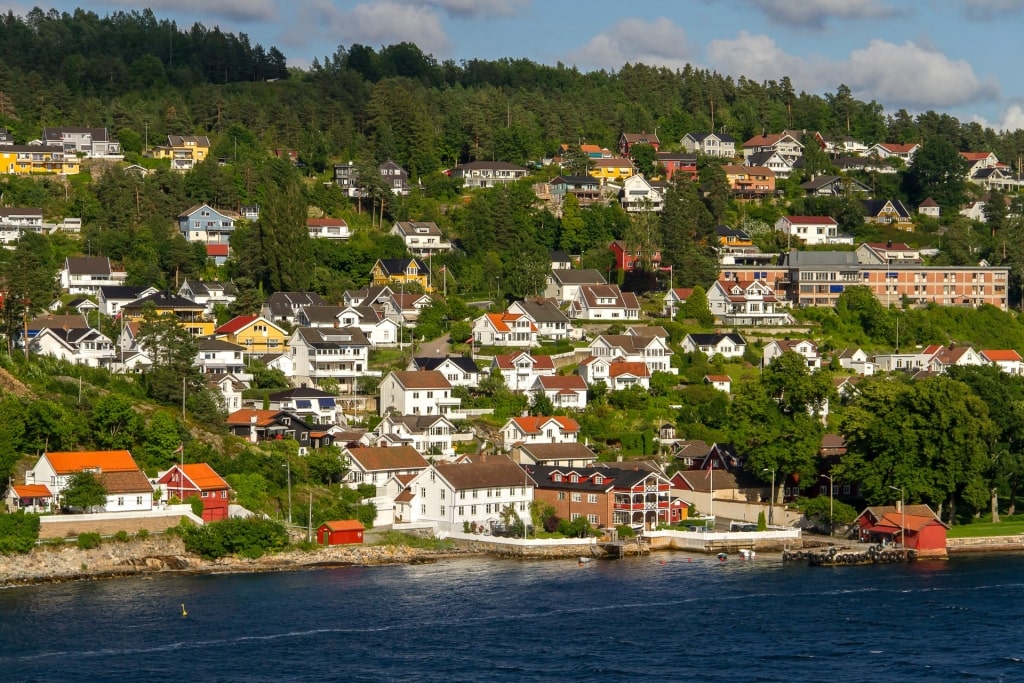
Inner Oslo Fjord
Sailboats and larger vessels fill the serene Inner Oslo Fjord during summertime, with tiny islands connected via a regular ferry service from City Hall Pier.
Oslo Ferries runs a service to many of the islands, including Hovedøya, Bleikøya, Gressholmen, and Nakholmen, home to sandy beaches, hiking trails, and even ancient ruins.
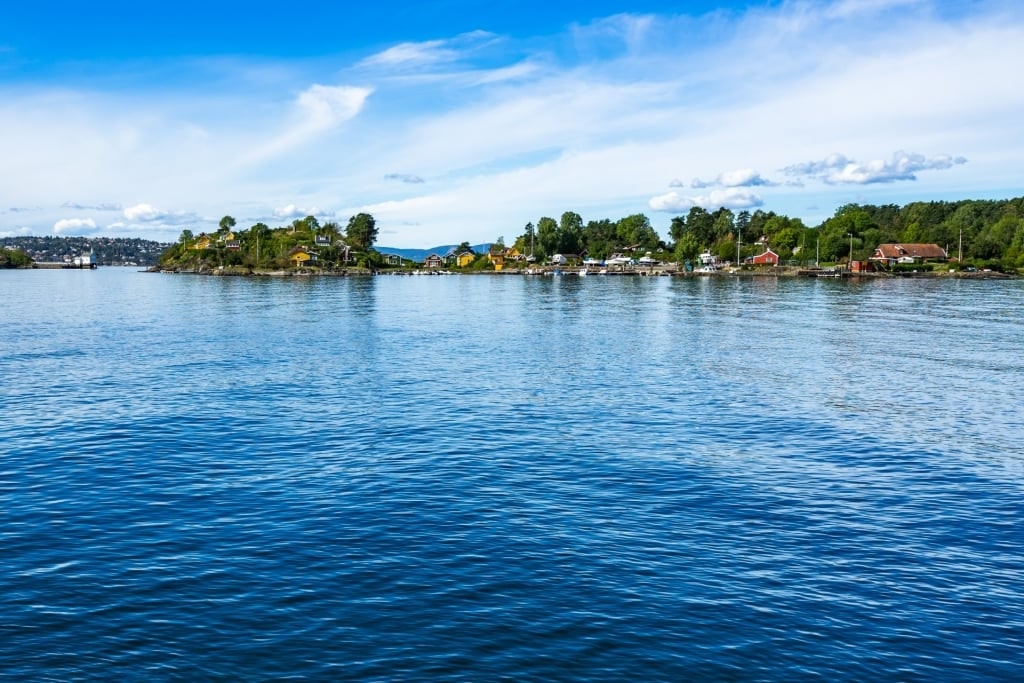
Hovedøya
Take a quick ferry to Hovedøya, the closest island to the mainland, to explore the ruins of a medieval monastery. The building was founded by English monks in 1147, who created a small church that was later added to the monastery and dedicated to the Virgin Mary.
The monastery was burned down in the 16th century and its remains lay underdiscovered until 1845. Nonetheless, it’s considered one of the most complete of Norway’s monasteries from that time.
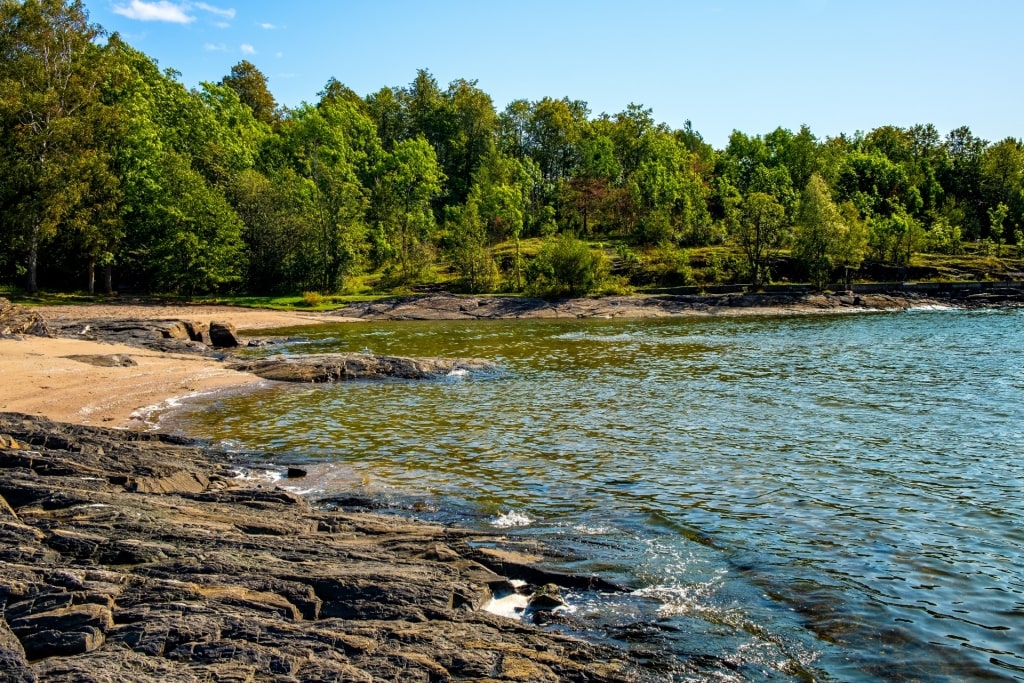
Gressholmen
Venture to Gressholmen, a forested island perfect for a more off-the-beaten–adventure. Hike among the greenery and take a swim off one of the island’s beaches. Pack a picnic or stop by the summer-only Gressholmen Kro for chilled sodas, beers, and ice cream.
You could also hop over to Lindøya to see the island’s glorious summer cabins. There are two beaches, a swimming platform, and a shop on the island.
Make a Trip to Bygdøy’s Museums
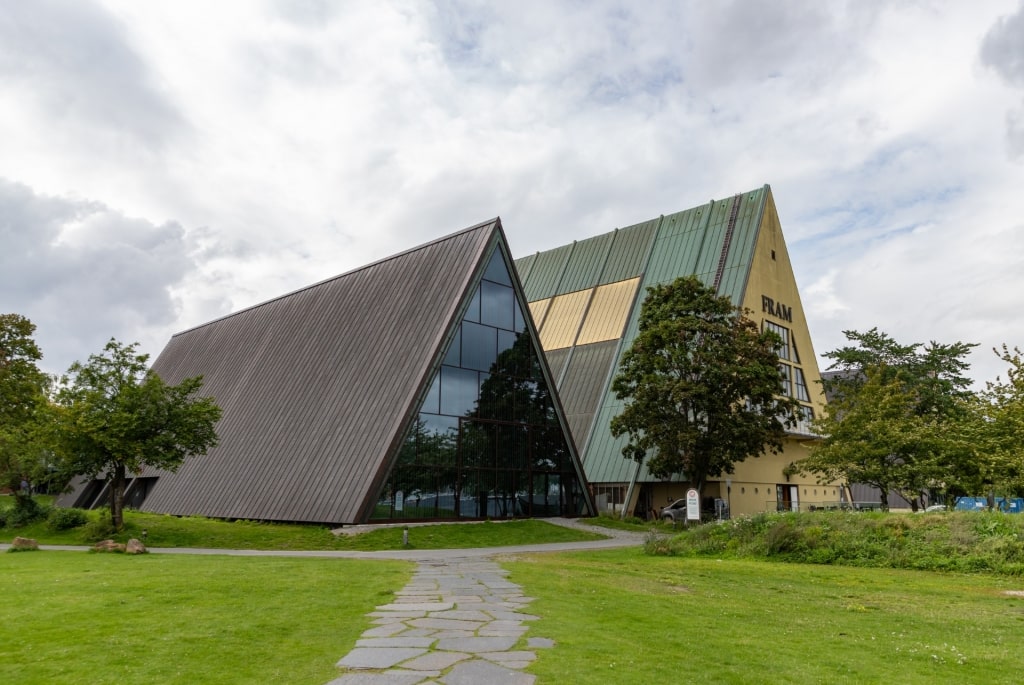
Fram Museum
Bygdøy, a peninsula in the west of Oslo, is home to a cluster of the city’s best museums, including the Kon-Tiki Museum, Norwegian Maritime Museum, and Fram Museum. A day trip to Bygdøy is one of the best things to do in Oslo to learn about Norway’s rich seafaring heritage.
The Kon-Tiki Museum is dedicated to the Norwegian explorer Thor Heyerdahl, who famously crossed the Pacific, the largest ocean in the world, on a balsa wood raft named Kon-Tiki in 1947. Visitors can explore more of Heyerdahl’s story and witness artifacts from his expeditions, including the original Kon-Tiki raft.
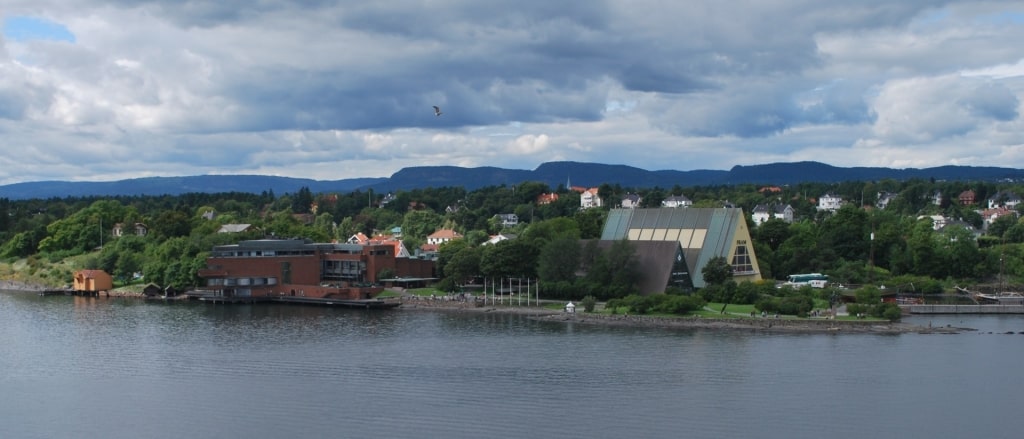
Norwegian Maritime Museum Photo by Helge Høifødt on Wikimedia Commons, licensed under CC BY-SA 3.0
At the Norwegian Maritime Museum, explore one of the original vessels from the Gokstad Mound, a site in the South of Norway where a Viking longship was excavated in the late 19th century.
At Fram, set aboard the wooden expedition ship that was used between 1893 and 1912 by Norwegian explorers Fridtjof Nansen, Otto Sverdrup, Oscar Wisting, and Roald Amundsen to travel to both polar regions. Fram is considered the strongest wooden ship ever built, with visitors given the chance to explore the ship and see how the crew lived. Don’t miss the polar simulator to experience what it was like to voyage to some of the harshest, most remote places on Earth.
If you plan on visiting all three museums, purchase a combined ticket.
Experience Oslo’s Sumptuous Food Scene
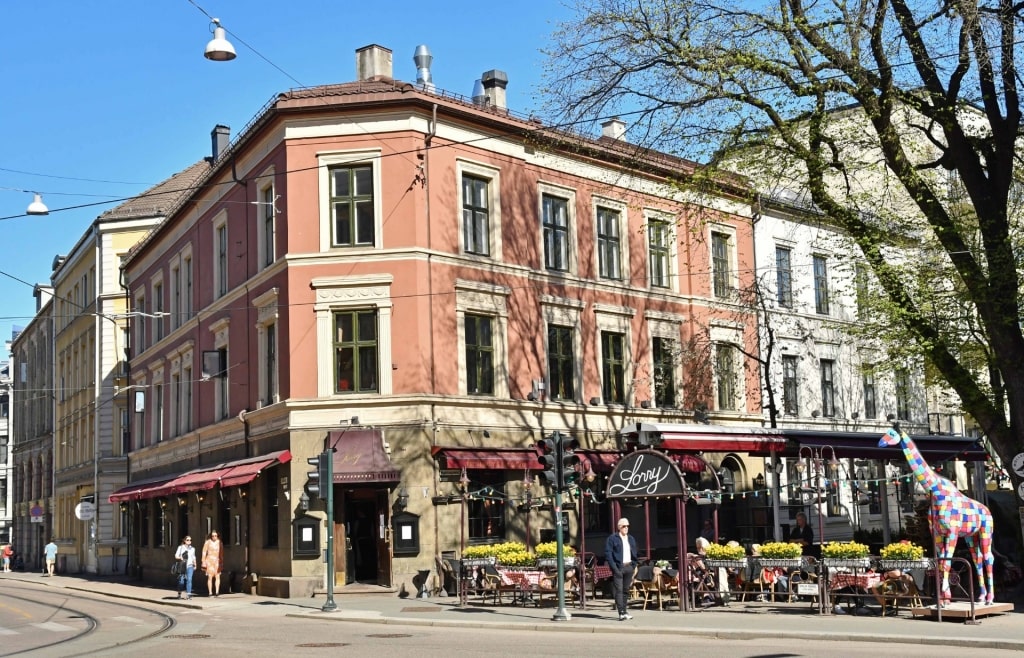
Lorry Photo by Helge Høifødt on Wikimedia Commons, licensed under CC BY-SA 4.0
Oslo’s dynamic food scene is bursting with fantastic flavors and innovative cooking, from street food vendors to high-end Norwegian gastronomy, and everything in between.
For a traditional Norwegian restaurant oozing character, head to Lorry, a venue that has welcomed patrons since the 1870s. For a light lunch, the Skagen sandwich (shrimp, roe, and egg mayo) is delicious, or for something a little heartier, try the Pytt i Panne, featuring pork hash, onions, beetroot, and eggs.
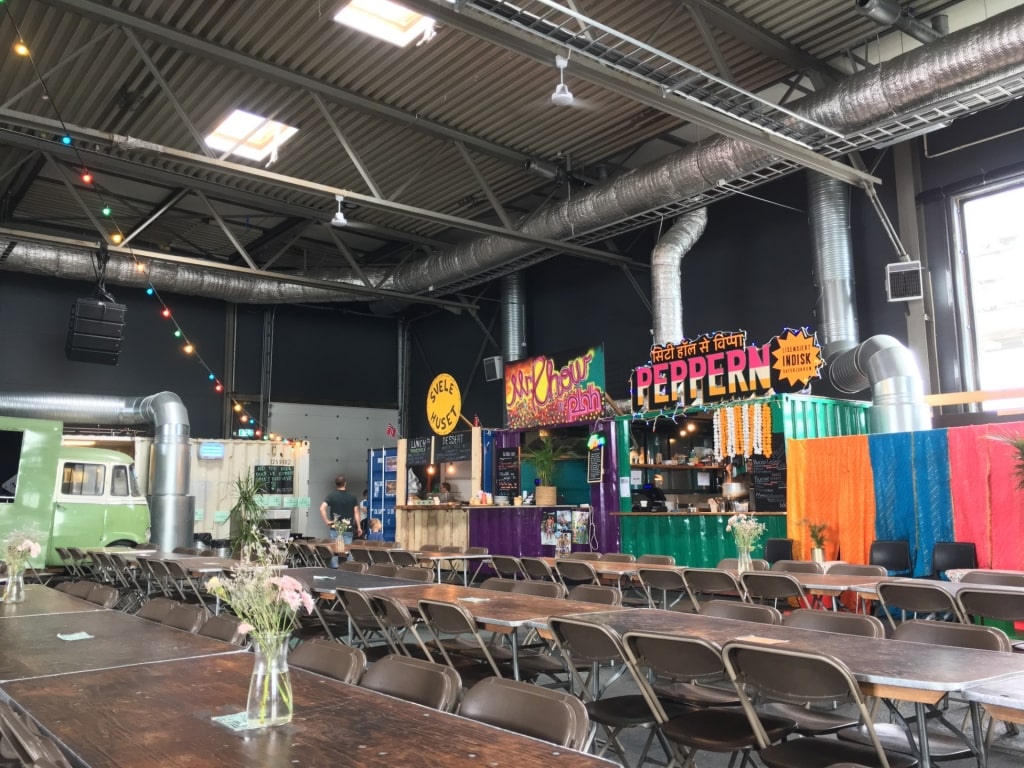
Vippa Photo by Olivier Bruchez on Flickr, licensed under CC BY-SA 2.0
Vippa is a funky warehouse packed with street food vendors by the waterfront. Dine on crab sandwiches, pork wontons, or Arabian pizza on long communal tables. This industrial building is enriched with vibrant art murals, and the venue hosts a program of events from concerts to lectures.
One of Oslo’s top comfort food spots is the humble hot dog kiosk, Syverkiosken. This family-run spot serves sausages in a traditional potato-based flatbread called a lompe.
If you’re a fan of fine dining, Maaemo is the spot for you. Expect a sophisticated setting, a finely-tuned menu by chef-owner Esben Holmboe Bang, and a focus on hyper-local ingredients.
Admire Contemporary Art at Astrup Fearnley Museum of Modern Art
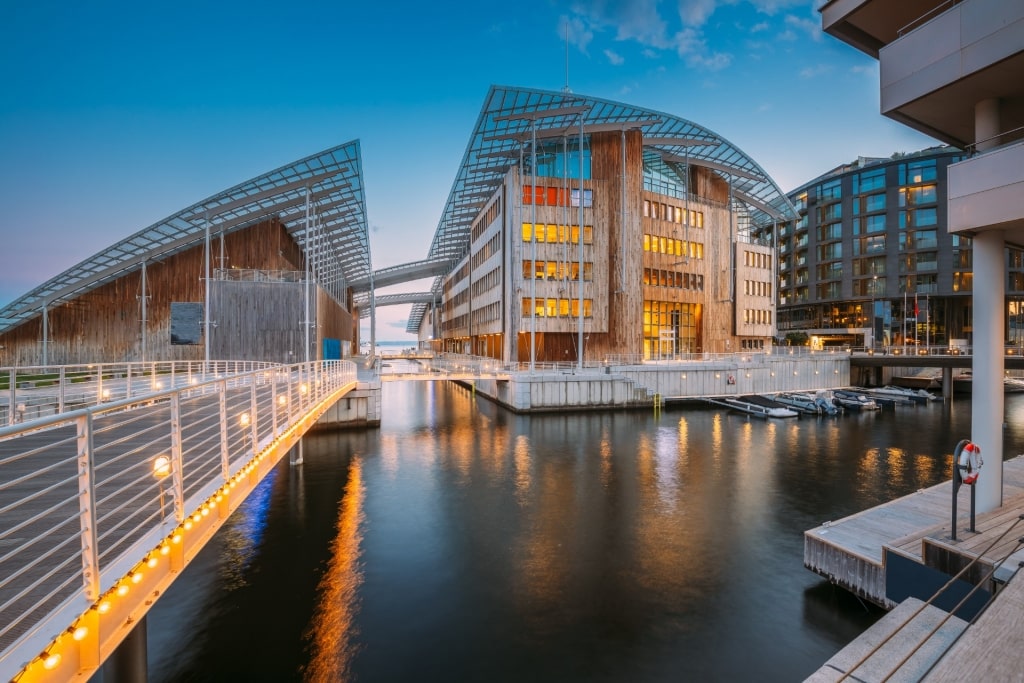
Astrup Fearnley Museum of Modern Art
Set on Thief Island, or Tjuvholmen, this exquisite museum opened in its current form in 2012, amid a warren of canals, bridges, and lawns.
The superb Astrup Fearnley Museum of Modern Art houses a vast international collection of contemporary art by the likes of Jeff Koons and Tom Sachs. There are several changing annual exhibits.
Browse the Astrup Fearnley collection, which began with a collection started in the 1960s by founder Hans Rasmus Astrup. The collection has grown to some 1,500 works, from 1970s conceptualism to 1990s installation art, and 2000s Norwegian neo-conceptualism.
Family workshops, gallery tours, and artist-led talks are all part of the museum’s action-packed program.
Step Back in Time at The Viking Planet
The Viking Planet brings this important historical era to life through a series of digital experiences, while showcasing artifacts on loan from Oslo’s Viking Ship Museum, which is closed until 2027 when it will reopen as the Museum of the Viking Age.
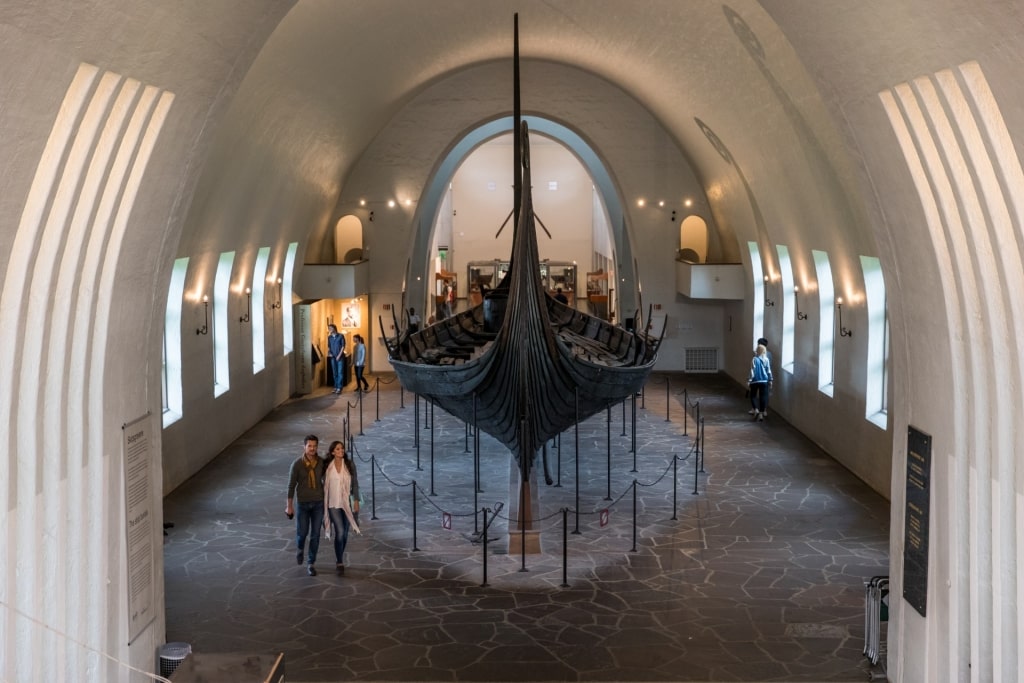
Viking Ship Museum
There’s a ferocious Virtual Reality combat game involving participants battling it out using bows and arrows, and swords.
The Viking Ship Exhibition explores the Oseberg and Gokstad ships and other loaned objects, such as jewelry and wood artifacts. Visitors can also don a headset for a virtual reality experience that takes participants on a hair-raising Viking longship journey to the dramatic west coast of Norway.
Swim at Sørenga Sjøbad
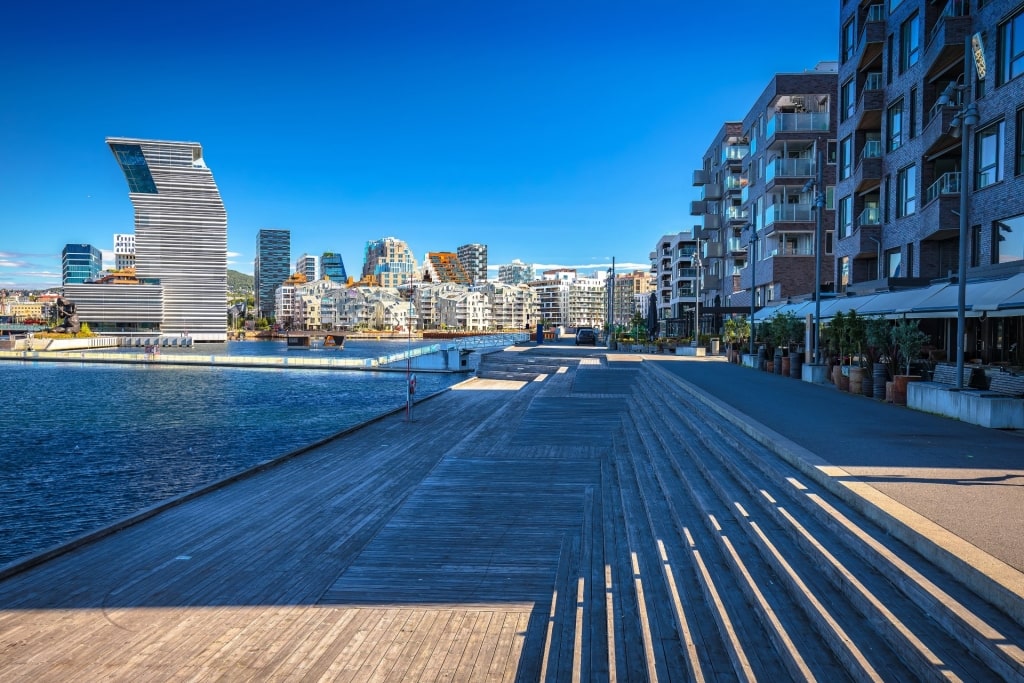
Sørenga Sjøbad
In the east of Oslo’s harbor, this large seawater pool presents a wonderful opportunity to swim in the fjord.
Open year-round, Sørenga Sjøbad is a social spot that’s particularly lively during summertime, with boardwalks wrapped around a swimming pool, providing easy access to the water, and lanes marked out for more serious swimmers.
There’s a children’s pool and plenty of space to relax and soak up the laid-back waterfront vibes. Sørenga Sjøbad has restaurants, cafés, and bars close by.
Go on a Nature Hike to Sognsvann Lake
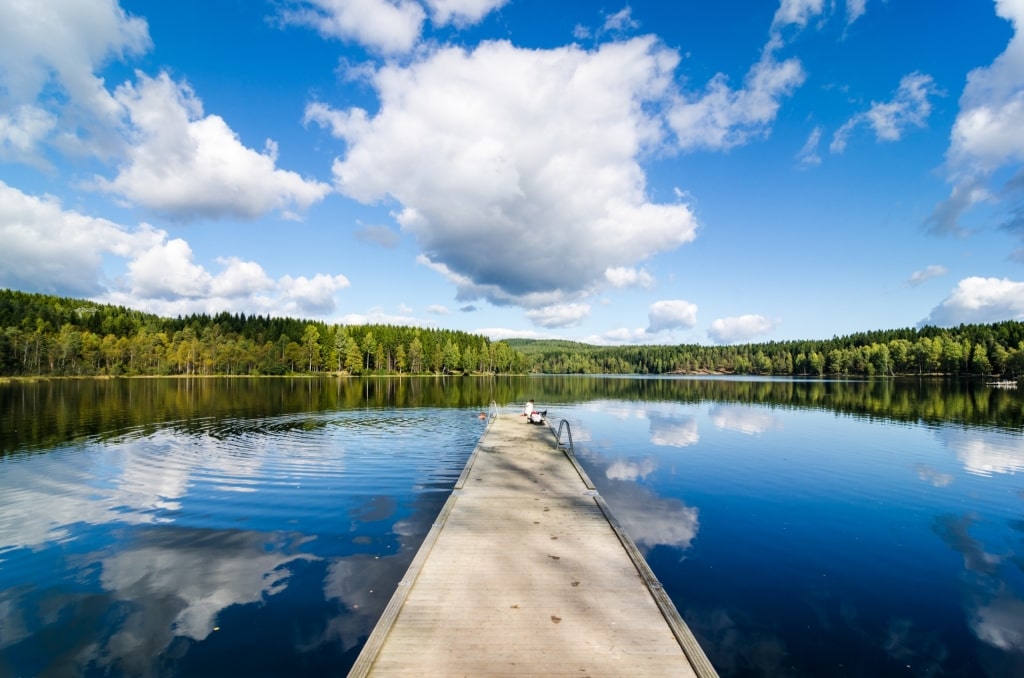
Sognsvann Lake
Oslo is surrounded by verdant forests and freshwater lakes, including the picture-perfect Sognsvann, a short drive or metro ride north of this Scandinavian city.
There’s a two-mile track around the lake, dotted with silver birch. It’s an easy hike, with picnic spots and places suitable for a refreshing swim. There are trails leading into the forest, should you prefer a longer hike, including one to Svartkulp, a smaller lake to the east, and Nedre Blanksjø to the north.
There are a couple of bathrooms by Sognsvann, but no grocery stores or cafés, so pack a picnic and enjoy lunch surrounded by Oslo’s pristine nature.
Read: Serene Lakes in Norway to Visit
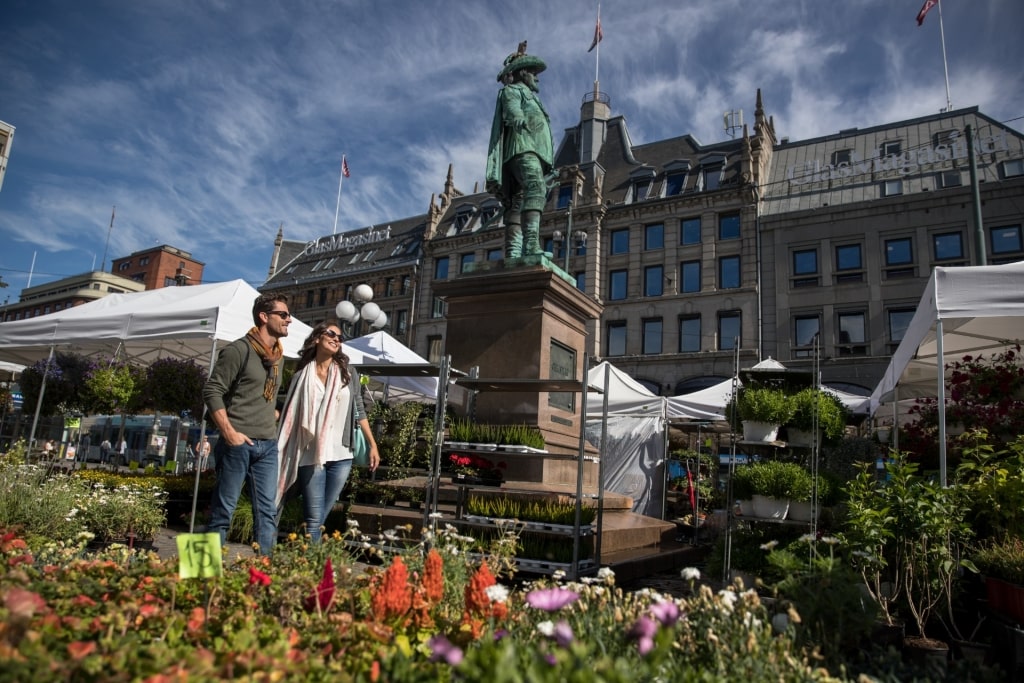
Stortorvet
Oslo is an extraordinary city for art, culture, nature, architecture, and gastronomy. Explore Celebrity’s cruises to Oslo to experience the beautiful Oslofjord and witness some of the spectacular nature that surrounds Norway’s capital.
